Company growth is a lot like playing a game of telephone. The larger your group, the more convoluted and tangled the original story gets. And the more your company grows (both in revenue and people), the more disconnected teams become, making it harder to collaborate cross-functionally. That said, growth doesn’t just touch your headcount or ROI, it impacts your customer experience too.
This article will define sales and marketing alignment and illustrate how (and why) it’s important. Plus, we’ll include tips and tricks to help you successfully align your sales and marketing teams — or at least corral them into a similar trajectory, making both marketing and sales strategies more effective and efficient.
What is sales and marketing alignment?
Today’s customer has high expectations — of design, products, services, and overall experience— and for good reason too. They have to wade through countless options, products, and services to find the right one that best fits their wants and needs. So it makes sense for them to maintain a rigid sense of discernibility and heavily weigh the pros and cons of companies they choose to do business with.
For companies large and small, the thought of this can be utterly daunting. After all, there’s only so much control you can have.
But that’s where sales and marketing alignment comes into play.
For all intents and purposes, sales and marketing alignment can be loosely defined as when marketing and sales teams share goals and work together to generate revenue.
While marketing and sales will still have distinct roles, aligning around the same goal ensures marketing and sales are communicating, guiding each other’s strategy and ultimately being more efficient.
Why is sales and marketing alignment important?
Aside from storing grain or water, silos aren’t good for much. Ultimately, silos prevent your sales and marketing teams from working together to achieve common goals — i.e. growing company revenue.
However, on a smaller scale, silos not only bottleneck workflows, but it hampers sales cycles, strategic goals become muddy, and sales teams aren’t able to make the most of the marketing leads, so your marketing team’s efforts get passed by the wayside and are underutilized.
At this point, it probably goes without saying that none of this is ideal.
Sales and marketing alignment helps prevent this. 87% of sales and marketing leaders say collaboration between sales and marketing enables critical business growth, and 90% agree that when initiatives and messaging are aligned the customer experience is improved.
What are some other benefits of sales and marketing alignment?
- Better equipped sales teams — When your sales and marketing teams are truly aligned and chatting regularly, your sales reps will be better prepared with the marketing materials they need to get through to leads.
- Clearer understanding of your customers — Another benefit of alignment is that sales can give regular feedback about what problems their leads are looking to solve. This will give your marketing a team a better understanding of your customers and will lead to more specific and effective buyer personas.
- Improved employee engagement — When teams are aligned and communicating, people feel heard. Both your sales and marketing employees will know your company is listening to their expertise and values them, which leads to overall improved employee engagement and satisfaction.
- Less frustration all around — Teams who talk to each other will eventually figure out a good way to communicate and work together — decreasing frustrations, silos, and misunderstandings.
- More sales and faster sales — And of course, when your sales and marketing teams are operating efficiently together, you’ll be making more sales and doing so faster. That’s the number one benefit of a well-equipped sales team.
To align your sales and marketing teams, there are a few small steps you need to take and processes worth implementing to ensure both teams are on the same page and working effectively.
Sales alignment = Aligned marketing
We know that there are only so many hours in a day, so we’re going to give it to you straight: transparent and consistent communication is the key to ensuring a successful sales and inbound marketing alignment strategy.
White it seems fairly simple, sales and marketing alignment is still something many companies struggle to achieve. Without proper resources (i.e., manpower), clearly defined roles, and a clearly defined strategy for sales and marketing, it can be hard to get into a properly aligned groove.
But the cost of misalignment is too critical to ignore. When your sales and marketing teams aren’t working well together, you run the risk of missing out on leads, not knowing your customer base, slowing down your sales velocity, and burning out your teams.
That said, there are a few foundational steps necessary to help facilitate effective communication and boost alignment. Consider these first three points as your starting blocks. Once sales and marketing are aligned on the following, you can get started on the nitty-gritty.
Start by aligning the following:
- Sales and marketing goals — Sales and marketing have similar goals. However, the difference lies within the time it takes to achieve these goals. For example, sales teams are driven by meeting a monthly (or quarterly) quota, which requires fast-paced flexibility and readiness at a moment’s notice. Marketing goals are less frenetic in nature. They wind up being more long-term and methodical in comparison to their sales counterparts. To achieve a happy medium between sales and marketing, you’ll want to identify overlap in goals and make specific goals surrounding that overlap to ensure success.
- Sales and marketing roles — Sales and marketing cannot be siloed into their roles: there has to be common ground between the two departments. Sales need to stretch and flex the leads that marketing supplies. Whereas marketing needs to equip sales with easy-to-use resources or content collateral that empowers them to push through quotas quickly and easily.
- Software and process crossover — Different processes and software work better for sales, and the same goes for marketing. Where you can, bridge the gap between the two by using the same processes and technology.
- Determine the lead qualification and follow-up process — Marketing and sales should have a clearly defined process for how marketing-produced leads are qualified and distributed to the sales team to be nurtured and converted. Sales and marketing managers should agree on lead scoring criteria and designate which sales reps are responsible for following up with marketing-generated leads. Formalizing this in a written service level agreement (SLA) will help keep both teams aligned.
- Business segments and personas — Having defined buyer personas and target segments is critical to sales alignment. By identifying which industries, job titles, and demographics make up your target market, your marketing team will know what content to create, and your sales team will know how to organize their teams and develop email tracks to reach those segments.
Tips and tricks to successfully align sales and marketing
Now that we’ve tackled the high-level information needed to help you get the ball rolling let’s dive into the details.
- Have the initial conversation — This is the moment to establish and chat about your common ground, inbound marketing goals, and so forth. Be sure to lay everything out on the table, identify overlap, identify potential weak spots, and establish processes to help prevent those weak spots from becoming a problem.
- Set up a recurring, weekly alignment meeting — Regardless of how much time you and your coworkers take to conduct the meeting, use this time to talk about hiccups, project progress, and other updates. Doing so helps you and other team members reduce the chances of duplicating work and ensures you all stay on the same page.
- Attend each other’s key meetings — The more informed, the better. It might be tedious and seem unimportant, but it can provide insight into future projects and reinforce the bond between teams.
- Implement a content request process — Sales enablement content is where marketing and sales wind up overlapping the most. A content request and production process can help ensure goals are met, cut down on duplicate work, and reduce the workload on creative teams, so everyone wins.
- Build and leverage templates — To prevent bottlenecks from popping up, create pre-designed and customizable templates for sales or marketing to utilize. That way, both sales, and marketing can keep cranking away at larger goals and projects — without dropping the ball on important yet small day-to-day tasks.
- Organize resources in one location — Store sales enablement assets in one easy-to-find location. Assets can range from templates, one-pagers, and other sales collateral, to brand guidelines and locked images.
- Create a content funnel — In an ideal world, you should be able to connect the dots between multiple pieces of content and create a content funnel. When aligning inbound marketing efforts and sales goals, be sure you are creating content for every stage of the funnel that tells a consistent story that develops as a lead moves through the funnel.
- Keep communication channels open — As time goes on, sales and marketing alignment will need to evolve and grow to reflect the goals of your company. Be sure to maintain an open line of communication between departments to promote and facilitate the growth needed to lock in maximum success.
The impact of sales enablement on content — and vice versa
At this point, you’ve probably noticed that content is an overarching theme within this article. For sales and marketing alignment to be effective in practice (and not just theory), your content production also needs to be in alignment, on-brand, and consistent as well.
After all, content is a powerful tool for both sales and marketing teams. But unfortunately, it’s easy for one team (be it sales or marketing) to dictate what content gets produced when it gets completed, and how it gets done. Instead of permitting this to happen, banish content production and sales enablement bottlenecks with Marq. Marq is an easy-to-use brand enablement platform that empowers anyone to create on-brand content. In turn, sales teams can quickly create the sales enablement content they need to close deals, while your creative team can focus on large-scale inbound marketing efforts. So, everyone wins.
The modern workplace has changed vastly compared to just a decade ago. It’s now possible to do business with companies and people on the other side of the globe, with remote and distributed teams scattered across continents and time zones.
However, one thing that hasn’t changed is the need for collaboration. In fact, it’s become even more of an imperative now that your coworkers can be located thousands of miles away.
Related: 7 best tools for project management
Many great work collaboration software are designed to help marketing teams, but it’s easy to get overwhelmed if you try to use them all at once. Here are some of the best, hand-picked team collaboration tools to make your marketing team more productive than ever.

Trello as a project management tool
Let me be completely honest: I’ve tried at least a dozen project management tools, ranging in price and complexity, and none beats Trello. In fact, Trello has become synonymous with “project management app” for many users across industries.
The beauty of Trello is that it’s so simple, anyone can get the basics within 20 minutes and become fully proficient using the Kanban board system. As an extra, it has countless integrations, and you can make it work with practically anything through Zapier or IFTTT.

Chanty as a team chat app
There is no collaboration without communication. When shouting across the office and sending emails becomes impractical and unmanageable, it’s time to introduce a team chat app. Although Slack has been the industry standard for quite some time now, many teams are dropping it in favor of less complicated and resource-intensive solutions.
Chanty is one of the up-and-coming team chat apps looking to take Slack’s crown. Boasting features such as unlimited message history, in-app task management, easy search options for messages and files and a growing number of integrations, it’s a no-brainer for teams looking for a Slack alternative. When it comes out of beta in the next couple weeks, Chanty will certainly shake up the team chat app market.
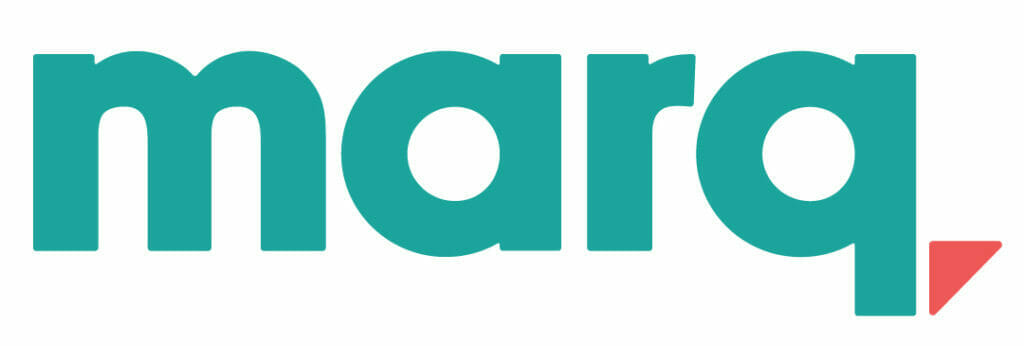
Marq as a collaborative design app
Design is traditionally a field with a strong necessity for communication and proper collaboration to do right. Unfortunately, sending an InDesign file to your colleagues and waiting for their feedback via email is far from the ideal way to collaborate on design projects.
Marq bridges the gap by providing an easy-to-use design collaboration tool that empowers coworkers to work together on designs in real time, with handy features such as responsive comments and live chat. No more messy emails or feedback lost in project management tools—you can now do it all within one app.

SugarSync for cloud storage
One app that made giant waves in the cloud industry is Dropbox, and it’s been the most popular app for years when it comes to storing, backing up and sharing data between individuals and teams.
SugarSync does everything that Dropbox does, along with some neat extras. For example, you can remotely wipe an entire synced folder, which can be especially handy for teams with remote workers. Moreover, you can also store your entire folder structure, along with the folder’s contents. This means that the path to your files will be the same, no matter the device used to access them.

Usersnap for reporting bugs
For developer and designer teams, one of the biggest collaboration issues is reporting bugs. When a QA wants to report an issue, they have to open a separate app and let the developers know what’s going on. This is anything but convenient, and there’s a chance that some of the message is being lost in the process—not to mention the fact that developers have to find the bug using the description from a QA.
Enter Usersnap, which lets you track bugs directly from your browser. You can annotate screenshots and request changes immediately instead of having to fill out forms and reports. This makes tracking and reporting bugs quicker and more efficient than ever before.

Salesflare for customer relationship management
Entering the CRM arena, the Salesflare team had their work cut out for them. Battling with giants such as Salesforce, Pipedrive and AgileCRM, it quickly had to prove its worth to make an entrance in the market—and so it did.
Its great design, ease of use and multitude of automation options are some of the many reasons why the app has so many raving fans. On top of it all, Salesflare makes it effortless for different stakeholders in the sales process to collaborate on their work.

Box Notes for collaboration in writing
If you’re in need of a collaboration tool that makes writing easier, but you find Google Docs clunky and just can’t imagine sending Word files as attachments, Box Notes is an excellent solution. Created by the Box team (known for their cloud storage app), Box Notes lets you create, share and edit documents with a team of up to 20 people.
Some other reasons to give it a try include options for sharing with non-Box users, version tracking, annotations and comments. Besides writing tasks, it can also be used for taking notes, brainstorming sessions, creating plans and more.

Appear.in for video conferencing
With remote work becoming less of an exception in the modern-day workplace, meetings no longer take place in offices. Instead, everyone hops on a call wherever they’re located for a video conference.
Back in the day, tools like Skype and Google Hangouts were the industry standard—until it became apparent that a more robust solution was necessary for business use. Appear.in is one of the most widely used video conferencing apps out there, with features such as conference rooms, group video calls and more. Like all other tools on the list, it stands out from the competition with its incredible ease of use. All you need is a link to the room, and you can hop on from any device with internet access.
Key takeaway
No matter whether you’re in the office, working remotely, or part of a distributed team, collaboration is a necessary ingredient to any brand’s success. Using the right tools, you’ll be able to communicate and collaborate more efficiently, getting more work done in less time.
Ready to take your team’s collaboration to the next level? Try Marq for free or schedule a demo today.
If you’re serious about upping your social media game, then brand consistency is key.
Many new businesses underestimate the amount of time and effort that goes into creating a social media presence that counts, and social media marketing is often seen as a cheap and cheerful way to spread the word about your business. While social media can be a fun and cost-effective marketing tool, it does eat up a lot of time. If you’re keen to invest that time in developing social feeds that make a difference to your business, you’ll need to have social media guidelines for keeping your brand consistent.
Related: How to drive traffic with social media
5 benefits to brand consistency on social media
Accomplishing brand consistency on social media isn’t easy, but it is achievable. Before we tackle how you can achieve it, let’s first consider why it matters.
It makes you memorable.
There are 500 million tweets sent every day, with 6,000 going out every second. When users see online content from a brand they can easily recognize, they’re more likely to remember them in the future, both online and offline.
It increases customer engagement and loyalty.
If customers remember and recognize a brand, they’ll feel much more comfortable interacting with them. Likewise, customers are more likely to stay loyal to brands who deliver a consistent message.
It helps you stand out from the crowd.
Having a brand that is easily recognized will help to set you apart from your competitors. There are 6 Facebook profiles created every second, resulting in around 500,000 new users every day. If you’re not consistent in branding your business across the various platforms you use, it can be easy to get lost in the crowd.
It gives you authority.
Branding that’s done well looks professional. It builds trust because it tells your audience that you know what you’re doing and you care about the details.
It makes you relatable.
Using social media to show the unique personality of your brand is an effective way of helping customers relate to you.
Tips for branding your social profiles consistently
To achieve visual brand consistency when setting up your social profiles, there are a few key things you’ll need to remember.
Names & handles
If you want your customers to be able to find you easily as they move from one platform to another, it’s important that your name and handle is the same wherever you are.
Colors & logos
Even before they read your name or bio, visitors will register your logo and the colors you’ve used. Make sure that these two things represent your brand in the right way. They should match your website and any other communications that go out to your customers.
Taglines
If your business has a tagline, display it prominently on your social profiles. Taglines are memorable, and using yours consistently will help your customers recognize you.
Still working on your brand basics? Read more: The 7 key elements of brand identity design
3 questions to ask before you start posting
Next, we’ll look at keeping your brand consistent when you post on social media—but before we do, here are a few important questions you’ll need to have the answers to.
Who is your audience?
The internet has 3.77 billion users and 2.78 billion of those are active social media users. To ensure your social media content is directed at the right sort of people for your business, you’ll need to understand a few things about your target audience. How do they identify themselves? What are their interests? What motivates them?
Who is the audience on each network?
Not everyone is on every social network, and if they are on two or more, it’s likely for different reasons. Consider what your target audience expects when they visit each social platform and how you can provide the content they’re looking for.
Social media management platform Hootsuite predicts growth in the following themes for 5 top social platforms:
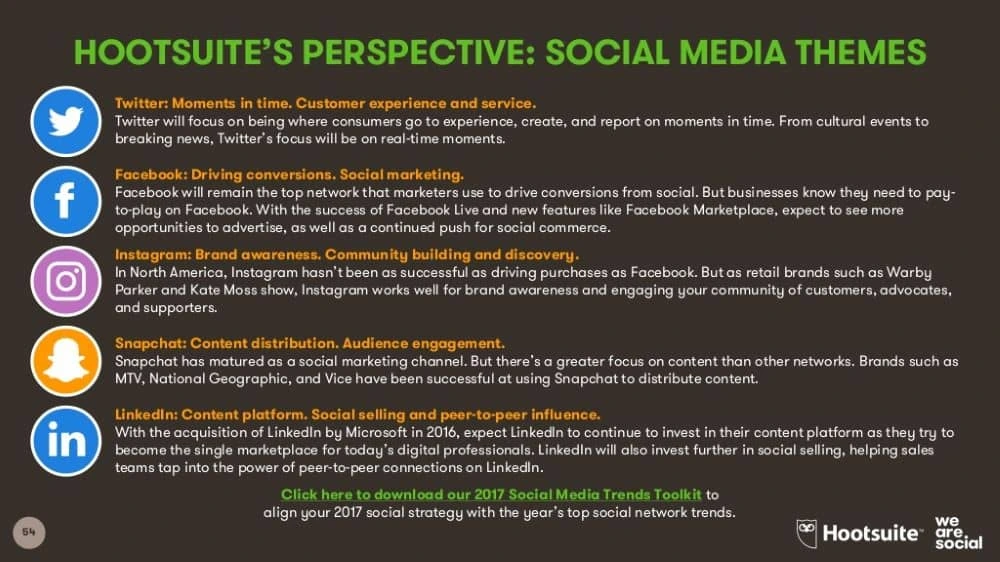
What language and tone will you use?
Deciding in advance whether you’ll use “we” or “I,” whether you’ll be funny or serious, and whether you’ll stick to perfect English or use slang and text-speak is an important move. There’s no wrong answer, it’s just about deciding what’s right for your audience. Once you know, make sure everyone in your business who posts is consistent.
Tips for social media posts with brand consistency
Once you’ve got answers to the questions above, you can start to think about when and how you’ll post and what you’ll share where.
Don’t just advertise.
The most successful brand accounts have a following because they offer something that their followers value. If you’re using social media just to promote and advertise, your audience will unfollow. What else will you offer: Promotions? Behind the scenes insight? Helpful information? Technical support? If you’re not sure where to start, check out the competition and see what works for them.
Post regularly and consistently.
Creating a social media account that stands unused can be harmful to your business. If a customer searches for you and sees that you haven’t posted for a while, they may assume that your business has closed.
Posting consistently can also help you develop a relationship with your audience and increase engagement. If they know when to expect a certain type of post from you that they appreciate, they’ll look out for it and may even begin to interact with you.
Consider your posting frequency per platform.
Posting regularly doesn’t have to mean posting all the time. It’s about quality over quantity. The frequency of your posts should depend on both the relevancy of your content and the platform you’re using. Do some research to find optimal times for posting based on platform and then set a schedule. There are free tools available online that will help you stick to it.
Curate content that fits.
Creating quality content for multiple social media platforms is a full-time job and, if your business is small, you simply might not have the resources. But you shouldn’t let that stop you from posting regularly. Sharing content from other people and businesses that echo your brand’s message is an effective way to keep the ball rolling while you’re working on other things.
Repurpose old content.
Likewise, there’s no reason why you shouldn’t repurpose old content. Share old posts that recent followers may have missed, or transform the content into something new. You could create an infographic from a long blog post, for example, or try breaking it up into smaller pieces and expanding on each one.
Don’t be repetitive.
While it’s important to post regularly, you should be aware of sounding repetitive. Don’t bombard your followers with the same message again and again, and be careful not to publish the exact same post across all your channels at the same time. Active social media users tend to jump from platform to platform within the space of minutes—if they’re seeing the exact same post from you wherever they go, they’ll start to feel overwhelmed by your content.
With that being said, if you’re running a big promotion or have an important announcement, you should certainly feature it across all of your social platforms. Instead of sending it out across multiple channels at one time, consider when the best times for posting on each channel are and stagger your message accordingly.
Link & cross-reference.
Don’t forget to link and cross-reference your social accounts. If you’re running a special promotion on Facebook, let your Twitter followers know. Likewise, if you have some content on Snapchat that you’re proud of, mention it on Instagram. Try only to do this when you have something your followers will appreciate—do it too much and you risk being repetitive.
Document your brand guidelines
There’s a lot to understand and remember, isn’t there?
If you’re committed to developing a social media presence that is both beneficial to and consistent with your brand, it’s worth considering documenting your brand guidelines.
Learn more about brand guidelines: 10 examples of great brand guidelines
Key takeaways
To achieve brand consistency on social media:
- Take care to ensure your profiles look similar and that they match your overall brand identity, including your website, newsletters and any other communications that go out to your customers.
- Make sure you know exactly who your posts are directed at and how you’ll communicate consistently with those people.
- Develop a social media content plan that outlines when and where you’ll post and how often. Work on ideas in advance and don’t be afraid to repurpose and curate, as long as you’re sticking with your overall brand message.
Ready to drive more brand awareness with social media? Grab a copy of our free eBook: How to adapt your brand to social media
Here’s a startling fact for you: marketing has changed.
(Gasp!) I know. It’s a frightfully unsurprising tidbit of information. But here’s the deal—it’s not only marketing that’s changed, it’s who’s doing the marketing.
Gone are the days where marketing meant a highly-trained marketer doing mass marketing to a mass audience while everyone else focused on running a company worth marketing for.
Related: How to survive the democratization of content creation in 2018 and beyond
These days, “everyone else” is significantly more involved. Employees, partners, vendors (the list goes on) are often involved in creating content that represents your brand. And since marketing, when it comes down to it, is any touchpoint your brand has with its consumers, this sort of involvement can be frightening to brand managers.
From email onboarding to Yelp reviews to customer support, marketing has slowly crept up on every department and every employee to hold each and every one of them responsible for properly representing the brand.
The problem? Not everyone knows how to properly represent the brand.
As businesses expand across locations, consistent marketing becomes a major issue. Old logos are used, images are stretched, colors are off-hue, and horrific clip art is inserted into marketing collateral. It’s a brand manager’s nightmare. So how do we fix it?
Enter distributed marketing management.
Definition time!
Distributed marketing management is the process of creating, managing, and delivering marketing content across a wide range of channels and locations—all while staying consistent along the way. It’s the 21st-century marketers’ solution to allowing brands to easily expand without disrupting their messaging or their time.
Distributed marketing, whether you’ve heard of it or not, has become a common strategy among organizations for tackling their larger-than-life and never-ending list of marketing tasks. Up until the last decade, businesses lacked a way to centralize their ever-expanding marketing needs and get their brand out efficiently without disrupting it.
Plus, with a growing number of potential channels, audiences, partners, distribution methods (should I go on?), any normal organization quivers at the thought of dealing with all the moving parts on their own. They need something that helps them centralize, customize and manage everything without wasting time and without stepping on toes.
The benefits. Oh, the benefits.
This distributed marketing management stuff (try saying that five times fast) makes life a whole lot easier for marketers. A few reasons why:
- Cloud-based, lockable templates. Brand compliance is no longer optional (hallelujah). Brand managers can lock down fonts, colors, and images in their custom templates before employees edit them.
- Permission management. The balance between corporate control and local autonomy is secured by defining which employees can edit, comment, or simply view marketing content.
- Marketing asset management. Marketing assets are centralized, improving the efficiency of teams, ease-of-access to branded files, and overall brand compliance.
- Multi-channel distribution. The distribution of marketing materials, whether print or digital, across a variety of channels is extremely simplified.
- Streamlined workflow. The back and forth between corporate and local employees gets rather old. Distributed marketing software allows for real-time collaboration and gives local employees the ability to make changes without waiting for the help of a corporate designer.
- Saved time. By allowing employees to create and execute multi-channel marketing campaigns on their own, corporate marketers can use their time for the bigger projects and problems they were hired to tackle.
- Consistent branding. This one’s no secret, and (I think) has been sufficiently covered in this post. But, if it helps, consistent brands enjoy 3-4x more visibility than inconsistent ones. Yet another reason to make brand consistency a major priority in marketing strategy.
Distributed marketing in the real world
Heard of MHA? Most likely not. But there are thousands of elderly in Europe who have, thanks in part to distributed marketing.
MHA, the Methodist Housing Association, was founded during World War II with the goal of providing shelter and resources for the elderly. Now managing over 90 care homes and housing over 5,000 elderly, the association has spread across England, Wales, and Scotland.
The problem MHA faced was a problem common amongst such organizations. The various homes and communities operated mostly autonomously until very recently when the organization decided to attempt unifying the groups into a single entity. Up until this point, the communities had been self-run, using their own messaging, mediums, and marketing tactics for almost 70 years. MHA marketing knew they had to find something that was cloud-based and easily managed.
With just a little bit of research, Kwan Cheung, MHA’s Community Marketing Specialist, discovered that template-based marketing with Lucidpress would solve his inconsistency issues almost entirely. He updated MHA’s brand guidelines, applied them to some custom templates, locked down the branded elements, and distributed the templates to MHA’s various communities for them to localize without disrupting the essence of MHA’s branded style.
From branded posters and flyers, to Facebook ads and digital newsletters—MHA finally discovered a way to keep their brand consistent without slowing it down. Thanks, distributed marketing! (Read the full case study here.)
At the end of the day, marketing will always be hard. Once you get the messaging down, it’s hard to distribute it properly and quickly. That’s why implementing a system that helps you easily customize and distribute materials, no matter how big your business grows, is honestly worth every penny.
Convinced your organization could use the help of distributed marketing? Lucidpress includes all the above-mentioned features and more to help you centralize and manage your marketing campaigns. Give it a try and start working some marketing magic today.
Social media marketing has immense potential for helping you attract brand awareness, website traffic, and even new customers. Even so, many brands remain skeptical of marketing on social media, because they’ve been unable to achieve their goals with it.
Is your brand present on social media? Grab a copy of our free eBook: How to adapt your brand to social media
The underlying issue could lie with any one of a host of decisions responsible for social media success, such as content, timing or campaign implementation. To give your brand the best chance at success, here are 7 social media mistakes to avoid.
1. Paying for poor shortcuts
Many marketers fall prey to the game of vanity numbers—a game that’s hard to recover from once it’s started. Remember: the size of your following doesn’t matter as much as the number of real engagements on your social media pages.
The focus of any social campaign should be to engage and delight your target audience. If an agency promises to quickly increase your page’s likes or follows, it’s likely to rely on underhanded strategies.
Unfortunately, likes purchased in bulk are worthless, because they won’t be from authentic fans and followers who buy from you or positively contribute to your online presence.
Instead: Invest in creating great content and organically engaging your audience instead of trying to buy their interest. One great way to do this is to reach out to the experts in your niche, share content created by them, and build a rapport in the community.

You could use a content curation app to source fresh, organic content that’s related to your niche, and then drive engagement with it. (Full disclosure: I work with DrumUp.)
2. Outsourcing without context
Brands who outsource their social media marketing usually do so because they believe it’s less expensive and time-consuming than building an in-house team. But is it?
You must totally, fully, completely trust the agency you choose to represent you online. Because if you don’t, and your decision backfires, it could be a disastrous mistake.
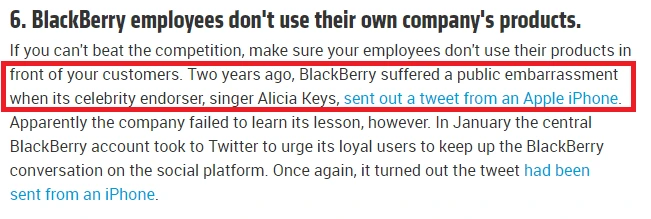
Even when you’re working with a reputable agency that isn’t likely to make such a mistake, there’s always a risk of being misrepresented, failing to capture your brand’s essence, or misunderstanding your expectations.
Instead:
- Communicate your brand’s vision, feel and personality.
- Set firm, clear goals and guidelines.
- Establish an approval system.
- Keep the line open for communication.
3. Being overly self-promotional
Being openly commercial has nearly become a faux pas in today’s online marketplace. Your audience is tired of ads—as the spike in ad-blocking clearly demonstrates. Nobody wants to be sold at anymore. They want to be befriended, entertained and wooed.
Instead, you should curate content and use your social media pages to establish your brand as a source of useful information and entertainment.
For example, Moz both creates and curates SEO-related content, which has made them the ultimate go-to for SEO on Twitter.

Takeaway: Curate entertaining or informational content that your audience will like. It doesn’t always have to be created by you. Find the balance, and don’t over-share your promotional content.
4. Spamming fans’ feeds
There’s no universal posting frequency that everyone should follow. Actually, it depends on your posts’ reach and impressions. Based on those statistics, you can select your frequency and time intervals for posting.
You can and should share a good blog post more than once. But avoid spamming your fans’ feeds with the same content over and over in a short period of time.
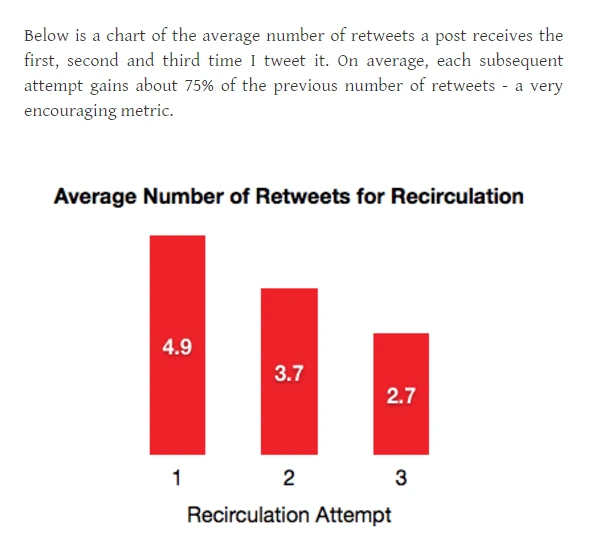
Instead:
- Create variations of a post with different lead-ins, featured images, and points of focus.
- Consider ways to re-purpose your content and share it in different formats.
- Share at different time intervals on different days, so your content reaches a wider audience and has a lower risk of showing up in the same fan’s feed.
5. Ignoring fan feedback
Studies show that 72% of customers expect a response within an hour when they post complaints on brand pages. When they don’t get one, they’re likely to think negatively about the brand.
How you handle negative feedback and the time you take to respond both matter.
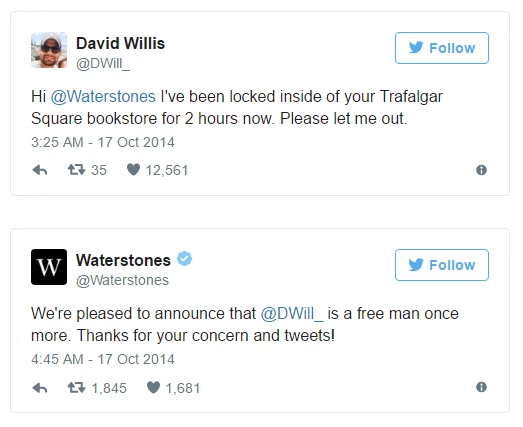
People are very likely to head to social media to post feedback, ask questions and complain, because it’s accessible and easy to do. That’s why many brands invest in full-time social media listeners and monitoring tools to help them maintain their brand’s reputation.
Takeaway: Never ignore fans on social. Acknowledge how they feel, and do your best to diffuse negative situations quickly. There are several social features like emoticons, GIFs and live video streaming that you can use to make followers feel like they’re being heard by other human beings.
6. Operating sans-analytics
Operating without analytics is like speaking without listening. [![]() ] Without analytics, there’s no way to know how your content is being received and whether it’s helping you move toward any goals.
] Without analytics, there’s no way to know how your content is being received and whether it’s helping you move toward any goals.
Every interaction on social media is feedback that you should consider when reviewing and refining your social media strategy. It’s also wise to track the flow of traffic, so you can learn which social platform is best for your brand.
Instead of flying blind:
- Measure important metrics like referrals, reach, impressions, engagement, leads, conversions, follower growth rate and mentions.
- Review your performance regularly, and take remedial measures to increase traction.
- A/B test your most important posts to optimize conversions.
7. Not being human
Humans are irrational and emotional beings, and this affects our decisions and how we feel about other people, situations, and even brands.
If you aren’t displaying your human side on social, you’re throwing away the ability to build lasting connections with your target audience.
Many brands invest in experienced marketing managers who specialize in building brand personalities and ensuring that they’re expressed through various channels.
Takeaway: Assign your brand a human personality that you can ‘be’ on social media. For instance, Old Spice sounds like a confident man with sophisticated, slightly dry humor.
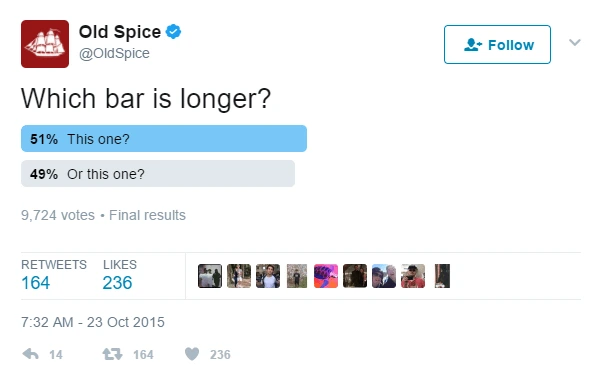
Another great idea is to put the spotlight on team members and customers who make your brand special.
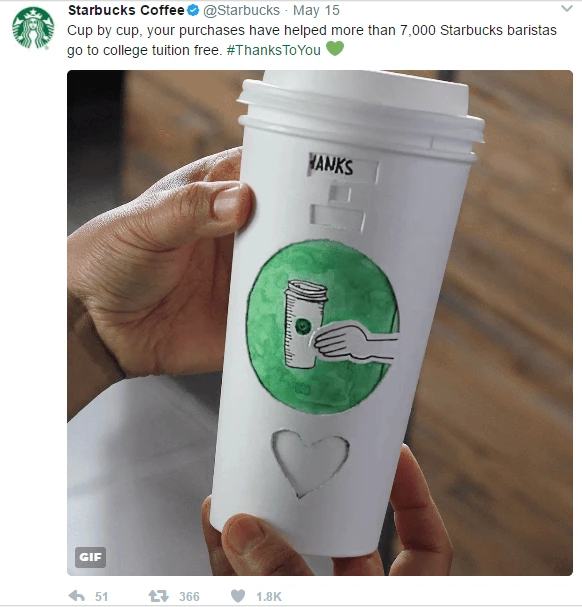
By taking care to avoid these mistakes, you’ll give your brand a leg up in the social media scene. Take a look at your social channels today and seize new opportunities to make an impact.
Ready to drive more leads and engagement with social media? Grab a copy of our free eBook: How to adapt your brand to social media
Instagram is the second-most popular social media platform, following Facebook. Currently, this photo-sharing platform has more than 700 million users and gets more than 4.2 million likes on its posts every day.
And since Instagram has opened its floodgates for businesses to advertise on the platform, marketers are jumping at the opportunity to appear in the news feeds of their target customers. And why wouldn’t they? A study conducted at the end of 2016 claimed that Instagram has 20x more engagement than Twitter and 15x more than Facebook.
Related: Free Instagram post templates
However, it’s also true that many businesses are failing to convince Instagram’s proactive and highly engaged user base to tap their advertisements. And it’s not just small brands—big names like Coca-Cola, Victoria’s Secret and McDonald’s also fail to capture Instagram’s full potential.
What mistakes are these brands (and yours) making which prevent them from mastering one of the fastest-growing social media platforms?
Let’s review the common missteps brands make while advertising on Instagram so that you have a checklist of what not to do.
1. You’re not being unique enough
Remember, there are lots of brands on Instagram vying for attention, some of which have similar products and target audiences as yours. Just as you compete with so many brands on the market, you compete for space and share of mind online. So how are you differentiating your brand from other brands with the content you create and share?
2. You have bad timing
When you post on any social media platform, the timing matters a lot. Though Instagram’s algorithm is relevance-based rather than time-based (that is, it generates users’ feeds based on their interests and activity rather than showing all items chronologically), you should still post at times when people check their social media apps the most. This will make it more likely that your content is seen, liked and shared—and the algorithm will amplify its exposure.
3. Your content is not focused enough
Instagram is not the place for crowded infographics or random pictures. Be thoughtful about the ongoing theme and presentation of your posts. Every user scrolling through their feed only stops to look at a post carefully if it catches their eye and speaks to their values. The better your content is focused around a relevant niche, the more chance a user will stop and absorb your post.
4. Your pictures are low-quality
Instagram is a visual platform, and people who use it regularly expect a certain level of aesthetic quality. Make sure your original photos are shot with proper lightning and in high resolution. If you use stock images, make sure they feel authentic. Keep the editing to a minimum so your images don’t look fake.
5. You don’t post frequently enough
Most brands believe that posting once or twice a day should be sufficient. However, according to a Union Metric study, brands that post once an hour enjoy higher engagement rates on all of their content—both posts and advertisements. Turns out that, in this case, more is more.
6. You’re misusing hashtags
It’s vital to understand the significant role that hashtags play on Instagram. Using too many, too few or simply the wrong ones—all of these can prove disadvantageous for your brand. Before using a hashtag, do some research to see what it’s primarily being used for. Aim for a few short hashtags that don’t distract from your message, so new people can find you but your current followers aren’t annoyed.
7. Your business account is private
Yes, it really does happen. There’s no good reason to keep your business account private, because the entire idea is to reach new audiences and gain followers. If you’re worried about privacy, make sure your business account is separate from your personal account. Rather than approving each new follower, open the gates and welcome the masses. You can always block troublemakers when and if they arise.
Summing it all up
With Instagram’s increasing popularity, it’s only going to continue to grow. As a social media platform, it’s intriguingly unique. It’s visual, it grabs undivided attention from its users, and it keeps users hooked with fun new features.
Yes, it requires some investment—but with focused creative campaigns designed specially for the platform, Instagram can bring you more conversions than any other social channel. More Instagram users prefer to shop online than Facebook users, so it’s a potentially lucrative channel to master. And by following these tips, you’ll be well on your way.
Newcomers to the world of brand awareness marketing often feel overwhelmed or utterly lost. There’s a veritable plethora of channels, tactics & tools to explore. To make things even more difficult, some make much more sense for your business than others, depending on a matrix of circumstances.
Related: 7 things to consider before your next social media campaign
Before jumping into a brand awareness campaign, remember to ask yourself these key questions.
Is your content tailored to the right people?
You’re pretty sure you wrote compelling content… but is that actually the case? It’s time for a bit of self-reflection and honesty, which—while sometimes tough to swallow—is vital to the refocusing process.
One of the easiest mistakes to make in brand awareness campaigns is tailoring the content towards current customers. In reality, you’re targeting potential customers instead. [![]() ]
]
The people you’re targeting likely have no idea who you are prior to seeing your ad. This is why the content has to be super compelling, either to draw them into visiting your site right away or ensuring that when they need a service or product like yours, you’re at the front of their mind.
The main things you need to include within the copy are:
- The unique selling points of your business—what makes you different from all of your competitors?
- How you can solve their problems—most consumers have some sort of problem (which is why they purchase services/products), so tell them how you can be the answer they’re looking for.
- A convincing call to action—whether this is telling them to visit your site, sign up for your newsletter or take advantage of a limited-time promotion or discount, tell people why they should act on their impulses now.
Put yourself in the shoes of your potential customers. What would you want to read? What would convince you to use your own product or service?
Marketers often forget to place themselves in the shoes of their target market and instead take a product-oriented approach.
Are you targeting the correct people?
Next, examine your target audience. Are you completely confident that you targeted the correct people? If your brand awareness campaign failed, then it’s possible you performed for the wrong audience.
Basing your target audience on your current customers seems like the place to start. They clearly love your brand, so people who share the same interests are your perfect target, right? Not necessarily.
In most cases, the audience you want to target is going to be slightly different. Before your current customer base found you, they were high-intent users actively searching for an answer to their problems.
In a brand awareness campaign, however, your audience isn’t likely to be high-intent when they first see your ads.
This is where you have to be creative; think about the types of people who may have pain points you can solve but don’t quite know it yet.
Think about the age range that’s most likely to face these pain points soon. Are there any geographical areas more likely to need your help? Are there any interests people have that could likely lead to needing you?
For example, if your brand specializes in decorating services, based on intent and life event options, you can target people who are moving soon or have recently moved. This would be more effective than simply targeting people who love decorating.
Are you tracking success correctly?
Finally, let’s review how you measure your brand awareness campaign’s success. You could run a hugely beneficial campaign, but if you’re focused on the wrong metrics, you may see it as a failure and not capitalize on it.
There are so many metrics you can use to gauge the success of a campaign that it can be difficult to know exactly what you should be looking for.
Success metrics should be chosen during the planning stage of your campaign, to give you a clear view of how the campaign should be structured and how you can get a sensible idea of the performance.
When you sit down to decide these metrics, use SMART goals and objectives. Many of you have probably already heard this acronym, but just in case, it stands for specific, measurable, attainable, realistic and timely.
Setting your goals this way will help you get an in-depth understanding of which metrics to evaluate when measuring the campaign’s success.
And when it comes to brand awareness campaigns, success can be harder to measure. Focus on top-of-funnel metrics rather than sales or conversions. When it’s over, don’t stop reporting just because the initial boost of traffic and engagement has died down. Remember that these campaigns can continue to pay off with gradual increases over time.
Common brand awareness mistakes
With so much on the line, you can’t afford to dive in unprepared. Here are 7 rookie mistakes that often fly under the radar yet profoundly impact your brand awareness strategies and goals.
Mistake #1: Scattergun approach
Spreading yourself too thin is an easy trap to fall into. You can’t please and cater to everyone—and you shouldn’t. In fact, attempting this futile endeavor will result in satisfying no one.
Case in point: many startups establish accounts on every social network they can, only to find that managing them all is virtually impossible. Even if you do post to every network with the help of automation, you’re not delivering a great experience tailored to that platform—and you’re likely missing out on a lot of engagement.
Instead, do your research to find a highly targeted market. Know who they are and understand their habits, wants & needs. You have to find where they are and spend time there, not in a hundred places where you desperately hope to stumble upon them.
Mistake #2: Passive social presence
A “build it and they will come” mentality does not work on today’s internet. You can’t just set up a website or social media page and hope to see customers eagerly interacting with your brand. First, you have to engage the audience. Responding to comments in a timely manner is a good place to start… but it’s only a start.
Come up with a content calendar and post on a regular basis. Talk to users and influencers, and ask them for opinions. Use your social presence to carry out customer service around the clock via instant messaging and other channels. Social media is about building lasting, meaningful connections that strengthen brand loyalty. You can’t simply stuff your messages with hashtags and expect magic to happen.
Mistake #3: Incoherent cross-channel strategy
Rookie marketers tend to lose sight of the big picture and how coherent their messages appear across different channels. This is not the way to build strong credibility and inspire trust. Successful brand marketing is deeply rooted in consistency.
This journey calls for much more than investing in a decent logo and slapping it everywhere you can. You will need to use elements like the color palette, fonts, visual identity, images, and voice to set the tone for your marketing campaigns. Tailor to the medium and the platform, of course—but never lose the integral pieces of your brand’s identity. [ ]
Mistake #4: Overcommitting to digital
Cost-effective digital platforms have unparalleled reach, but they are not be-all and end-all of brand marketing. Not everyone is tuned in to social media, apps and online search. Depending on your target market, you could work wonders with print collateral or merchandising.
In other words, you can let human psychology work to your advantage and leave a lasting impression by giving away branded office supplies, quality printed shirts, and other handouts. Don’t overlook the potential of printed media. You could reach a lot of people via brochures, business cards, flyers, newsletters, and other printed marketing materials. In the digital era, print is personal and memorable.
Mistake #5: Going all-in on advertising
Advertising is the mainstay of many brand awareness campaigns. However, it’s generally a bad idea to put all your eggs in one basket-especially if you’re a rookie who’s worried about wasting your budget.
What’s more, people have grown weary of aggressive pop-ups & ads, even when they’re targeted with laser-like precision. They install ad-blockers to completely shut them down.
Instead, try to start small and set aside a limited ad budget. Test your awareness campaigns over a course of few weeks and evaluate the results. Paid marketing works best when you prioritize ROI, so as you learn the ropes, gather data and scale your campaigns based on your insights.
Mistake #6: Misunderstanding content marketing
Viral marketing is one way to enter with a big bang, but directing all your efforts there is a double-edged sword. If you win, you win big. If you don’t, you get nothing. You’re probably better off crafting compelling, quality content on a consistent basis. Be entertaining, educational, and add value to people’s lives.
Once you start producing a stream of relevant content, you have to promote it. Bear in mind that you might not achieve immediate success. Don’t cut corners, and show patience. It takes time to gain momentum and traction. In due time, your efforts will start to snowball via word-of-mouth and social signals.
Mistake #7: Disregarding or copying the competition
It always pays off to scope out the competition. Doing this homework will show you what works for them—and what doesn’t. You gain valuable insights that help you set your brand apart. You should always keep an eye on what others are doing, but refrain from imitating them.
Looking and feeling like another business stirs brand confusion and slows the development of your own reputation. Instead, being genuine is the best way to win people over and keep them in your camp. That being said, you can still borrow good ideas and implement them in your marketing strategy. Just make sure you’re doing it in a way that’s fresh and authentic to your brand.
Key takeaway: Brand awareness by design
Effective brand awareness campaigns are hard to pull off. You have to put the right messages in the right place and serve it to the right people. Much easier said than done. There’s a lot of ground to cover without losing your footing and plenty of tools to consider.
Right away, put a sound strategy in place and let it guide your efforts across channels and platforms. Steer away from common mistakes that can bite off a big chunk of your budget and hinder your brand. Concentrate on turning curious visitors into prospects, prospects into customers, and customers into satisfied brand ambassadors.
Higher ed is getting social. With such a large audience, from students, prospective students and faculty to alumni and sports fans, the potential for social media in higher education is huge.
Benefits of social media in higher education
Student recruitment
It’s a well-known fact that younger generations use their phones more than older ones. This is where they conduct research on products, services and organizations. Universities can (and should) take advantage of this for recruiting. If universities want to attract students, then they need to have an engaging brand presence online.
Related: How to take charge of your university’s branding
Build your brand
Social media can be a powerful tool for building brand awareness. From highlighting new research to showcasing student projects and achievements, higher ed social teams can play a powerful role in attracting potential students, faculty and donors to the university.
Boost student engagement
Engaged students are more likely to stay enrolled and graduate. They are also more likely to become brand advocates encouraging their friends, family and children to participate with your university in the future. Taking a fun or lighthearted approach with content on Instagram or Tik Tok will resonate with students in a way that official announcements won’t.
Higher ed social media strategies
Establish your brand
Whether your higher ed team has been using social media for a while or is completely new to it, you should make sure that your brand is well-represented on your social media accounts. You never want potential students to come across your profile and wonder if it’s the university’s actual account. It should be obvious. Some things that will help establish your brand on social media are:
- Username/handle: Keep usernames the same across all platforms. This way, students can easily find you on Twitter, Facebook, Instagram and any other platforms you’re on. If you’re concerned about being able to register the same username across all platforms (and don’t want your handle to end up like @Lucid_press0018), here’s a tip. You can create accounts on new social media platforms, even if you don’t want to use them yet. Later on, if you find that your audience is using that platform, you’ll already have the username.
- Images: Just as usernames should be the same across platforms, your profile pictures should be easily identifiable. Along with your profile picture, using similar colors (such as school colors) in your images will further affirm your identity. A tip regarding the images you post: choose one or two photo filters that fit your brand, then only use those filters on any images you post. This creates a uniform look for your content that will be recognizable to your audience.
A great example for establishing your brand on social media is Coca-Cola. All of the Coke accounts feel familiar. Each picture uses a similar filter that’s cohesive with their branding, and you can see red in all of their images.
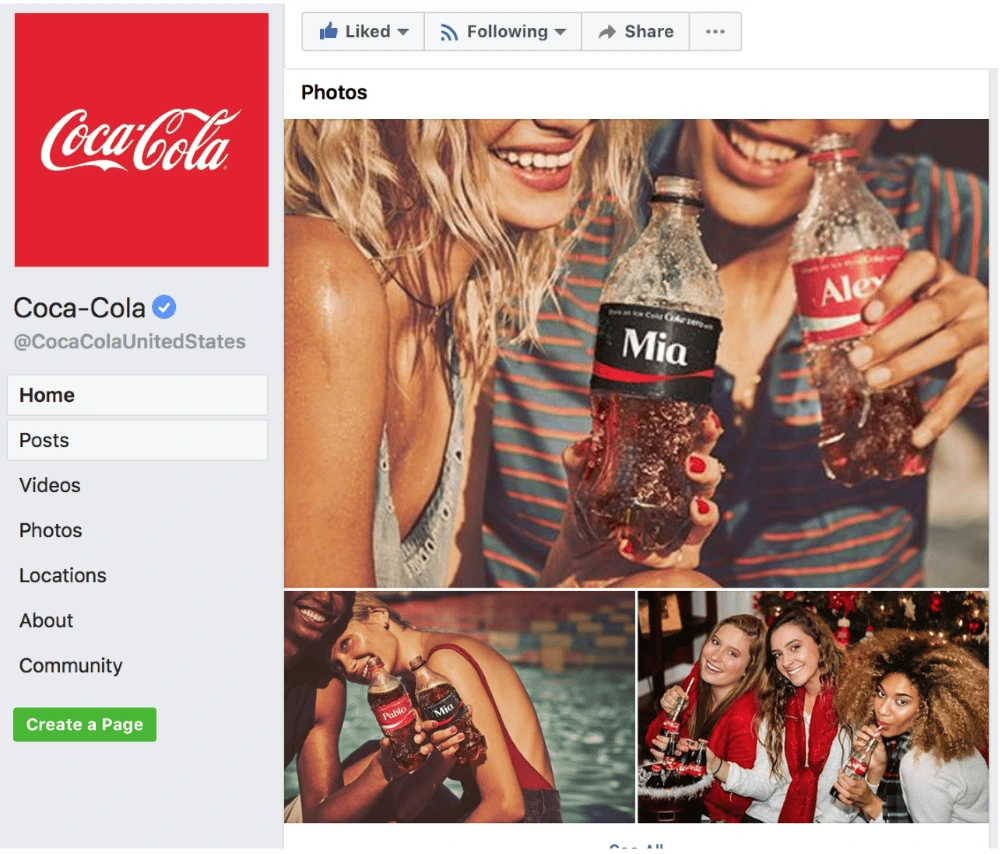
- Bio: Most social media platforms offer a place to include a bio for your university. Don’t waste this space. Bios are an excellent opportunity to show students what’s important to the school. You can even include a link to a page where interested students can learn more about the university (for example, by signing up for a newsletter).

- Tone & voice: Before you start posting, decide what your brand voice will sound like online. Will you be dry and professional? Will you use slang? The same goes for finding the right tone to use in your posts. Will you be happy, neutral, silly, snarky or witty? These decisions will shape your brand as people come to associate that voice with your university.
Speak to your audience
When it comes to social media, go where your audience is. Post content that’s designed for the platform and meaningful to them.
- Use the right networks: Are prospective students using Instagram, Snapchat or Facebook? Find out where your audience is, and start building a presence and community there. Some platforms might seem difficult to use as a university, like Snapchat. This is where you get to be creative and connect with students in innovative ways that no other universities are using.
- Create content specifically for your audience: What do potential students want to know? Share successes your school has experienced, student activities on campus, tips for prepping for college, what to bring to a new dorm room, what research is happening at your university, etc. Find out what your students are curious about, and create content that’ll be interesting and useful to them.
Harvard University’s social media often posts student-related stories that are relatable to other students. By focusing on the students, it shows that they come first at Harvard. Here’s an example of a personal story that was shared on the Harvard Facebook page:

Key takeaways
Social media is no longer a “nice touch” for your higher ed marketing plans; it’s essential to establishing your brand online. Build your profiles with consistent usernames and imagery. Create a guide for staff members that includes the colors, photo filters, logos, tone and voice to use in university-branded social media to maintain consistency.
Finally, make sure that you’re on the right platforms, sharing content that’s engaging for your audience. Use the same voice in comments, personal messages and public posts. Be where your future students are, and give them a reason to notice your university.
Memes are one of the most popular forms of expression online, and for good reason. First of all, they go hand-in-hand with just about any social media platform, which helps them spread like wildfire. Second, people have fairly short attention spans online, so the concise nature of memes makes them a perfect medium for quick consumption.
Related: How to create social media posts that get noticed
Memes are like an inside joke everyone wants to be in on. They’re a fun way to reflect on current events, clichés and trends. Memes are popular among brands because they engage audiences and drive traffic. If you’re thinking about using memes in your social media marketing, this guide will help you get up to speed.
What’s a meme?
The term itself was coined several decades ago by the evolutionary biologist Richard Dawkins. In his book The Selfish Gene, it refers to the way an idea spreads from person to person within a culture. Like genes, they replicate and change as they spread. Some of his examples include catchphrases, melodies, fashion, and even the technology of building arches.
Today, we understand the concept a little differently, thanks to the internet. Memes are still representations of ideas, and they still spread from person to person, but they involve an element of human creativity.
Simply put, a typical meme is an image or photograph accompanied by a caption that’s funny, ironic or entertaining. Although memes have many different permutations, effective memes are instantly recognizable.
Early internet memes
Before the days of social media, memes were shared via email, blogs and forums. One of the first memes was the Dancing baby, which was so popular in the 90s, it made a cameo on the TV show Ally McBeal. Another popular early meme was the Hampster dance, a webpage born as the result of a competition between two sisters to generate the most web traffic.
Memes can grow and evolve, and they don’t necessarily have a short shelf life. For instance, the LOLcats meme is still around—ancient by internet standards. Rickrolling was huge a decade ago and has mostly been put to bed, but Westworld’s creators recently decided to post a video containing spoilers for its next season… which turned out to be fake. Another enduring meme is a video clip from the movie Downfall, which chronicles Hitler’s last days and has inspired numerous parodies—usually by pairing the serious scene with a frivolous topic.
Other types of memes
- Rage comics. These memes use a library of pre-made cartoon faces (or “rage faces”) to express a particular emotion. Usually, they humorize a relatable experience. Because they use facial expressions, they’re easy to identify and understand. Examples include the Trollface, Like a Boss, Cereal Guy, and Forever Alone Guy.

The iconic Tootsie Pop ad reimagined as a rage comic
- Image macros. Probably the most recognizable type of meme, these are images that feature a witty caption or catchphrase. Thanks to meme generator sites like I Can Has Cheezburger, most of these memes use a bold, white Impact font with a black border (like the header image of this post).
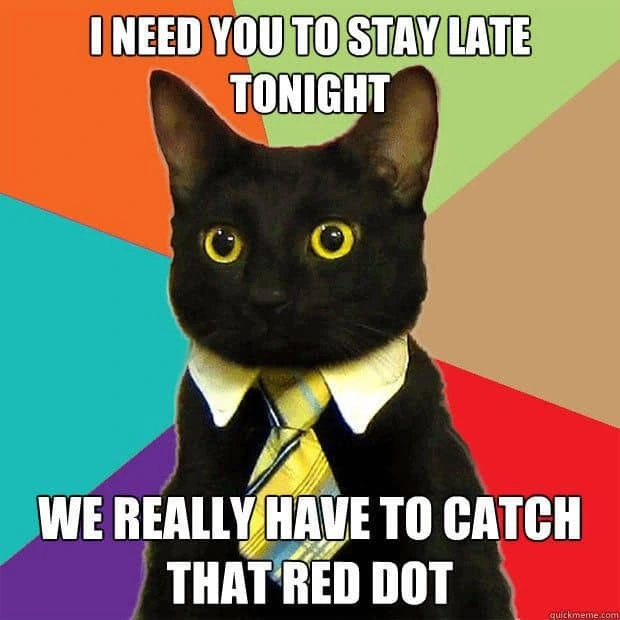
The internet is powered by humorous pictures of cats.
- Trending memes. This type of meme bursts onto the scene, feels ubiquitous for a few weeks or months, then disappears and nobody ever mentions it again. They’re often tied to current events, news, popular culture and trends.
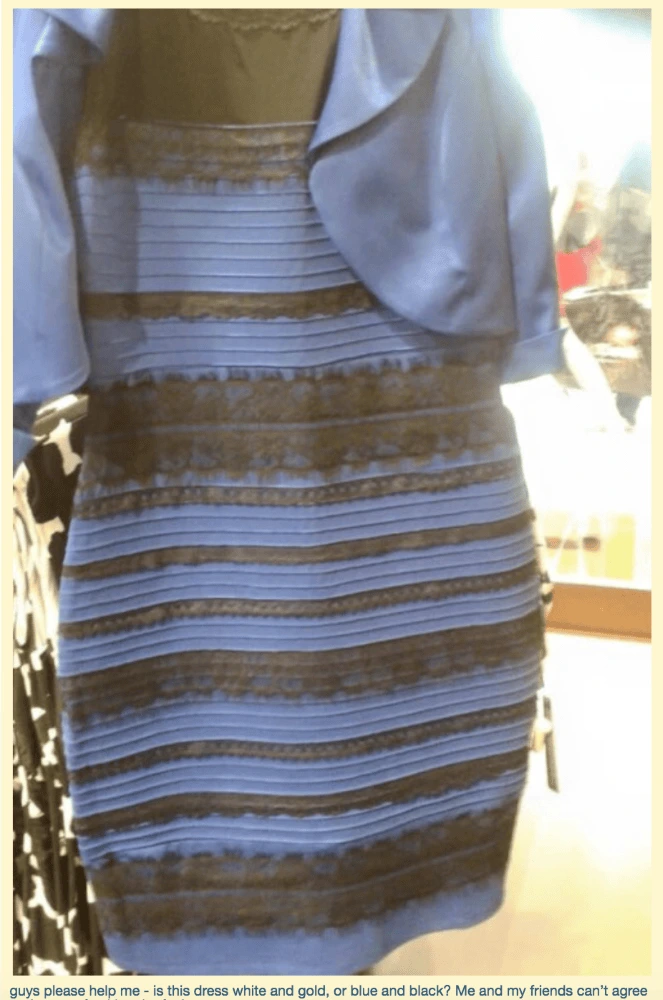
Ahh, yes, the “Yanny vs. Laurel” of its generation. (2015, that is.)
- Exploitables. Exploitables come in various forms, including single-pane or multi-pane comics, but the central idea remains the same: a template that’s easy to modify into new permutations of a joke. Four-pane comics are an especially popular exploitable format.

About 802 now, if you’re still counting.
- Copypasta. Unlike many memes, copypasta isn’t visual. Rather, it’s usually a section of text that gets copied and shared over and over. It’s most commonly used as a response in forum discussions and social media comment threads.

Since most recent examples are wildly inappropriate for this blog,here’s an oldie but a goodie.
The rules of using memes as a marketer
Like any type of humor, using memes as a brand poses a certain amount of risk. You don’t want a poorly constructed or offensive joke to confuse or drive away your audience. So, before you start spamming your social media feeds, review these simple guidelines.
- Decide whether memes are appropriate for your brand. Memes are predominantly created and shared by younger audiences. To get the joke, you have be clued into the broader online discussion. If your marketing campaign is aimed at an older audience, they might not follow memes or get the reference. Thus, your attempts at humor could fall flat.
Also, consider brand voice. If your brand uses a serious tone, memes probably won’t help you establish credibility or authority. Research your audience and review your brand guidelines before introducing memes into your strategy. - Don’t overdo it. In a way, memes function like a good jump scare in a horror movie. They can be incredibly effective 1) when used sparingly and 2) when the timing is right. Using them all the time will diminish their impact and bore your audience.
- Memes can’t replace original content. Memes can be a great addition to your content, but you can’t rely on them all the time. They’re there to amplify your message to a broader audience. All memes and no content is like eating dessert but never actually having lunch—fun at first, but eventually, you’ll want something more substantial to chew on.
- Be thoughtful. Memes can easily backfire if you’re not careful about the tone you use to get your point across. Sarcasm and irony don’t always translate well via text, which can cause confusion or backlash among your audience, despite having the best intentions.
Additionally, make sure you research and understand the origins of a meme before you use it. It might have problematic connotations (like racism, sexism or ableism) that you don’t want associated with your brand. Know Your Meme (potentially NSFW) is a great resource if you want to learn more about a particular meme.
3 examples of brands using memes on social media
There’s a veritable boatload of brands using memes effectively out there, but here are a few of our favorites.
- Seamless. A few years ago, food delivery service Seamless introduced a meme to join the buzz surrounding the Oscars. This one took the form of a hashtag; you can still find them by searching #OscarNomNoms. The idea was to use puns and wordplay to parody popular movie titles. We especially loved made-up titles like “Gravitea,” “American Mussels” and “The Wolf of Waffle Street.”
* Nickelodeon. Nickelodeon uses clips from its own cartoons to create memes, then posts them to Twitter and Instagram. Usually, they focus on issues younger viewers can relate to—such as going to school, having an annoying sibling, or enjoying time alone when parents aren’t around.
* Hipchat. In a move that seems like it never should have worked, Hipchat brought an existing meme into the real world by putting it up on billboards. Even though it’s a clear example of offline marketing, the digital search for HipChat rose 300%! In this case, being bold definitely paid off.
Key takeaway
Although individual ones come and go, memes are here to stay. They’re easy to create and even easier to share. From a marketer’s point of view, they’re inexpensive and have the potential to go viral. Still, they require you to research their content, your audience, and your brand. When all these elements align, memes can spread your brand message to a broader audience than ever before. To the moon! ???
Do you struggle to manage your real estate brokerage? I don’t blame you—your list of tasks can feel overwhelming. With tracking leads, managing commissions and uploading new listings, there’s a lot that goes into selling properties.
But, there’s one thing that can help: Software.
Related: Should you hire a real estate marketing agency?
If you’re enlisting the help of real estate software to help you manage each task, you could cut the time you spend on each activity—and boost your productivity in the meantime.
In this guide, we’re sharing a list of 12 incredible real estate softwares you can use for each major task you’re handling on a daily basis.
1. Copper CRM
Is your inbox out of control? Whether you’re inviting leads to an open house event or coordinating with someone selling their home, you might be struggling to remember who’s who.
That’s where Copper (formerly ProsperWorks) helps.
Because Copper is a CRM with G Suite integration, you can create profiles for each person you’re emailing—allowing you to follow email conversations and manage leads directly from your inbox, without needing to switch between several apps.
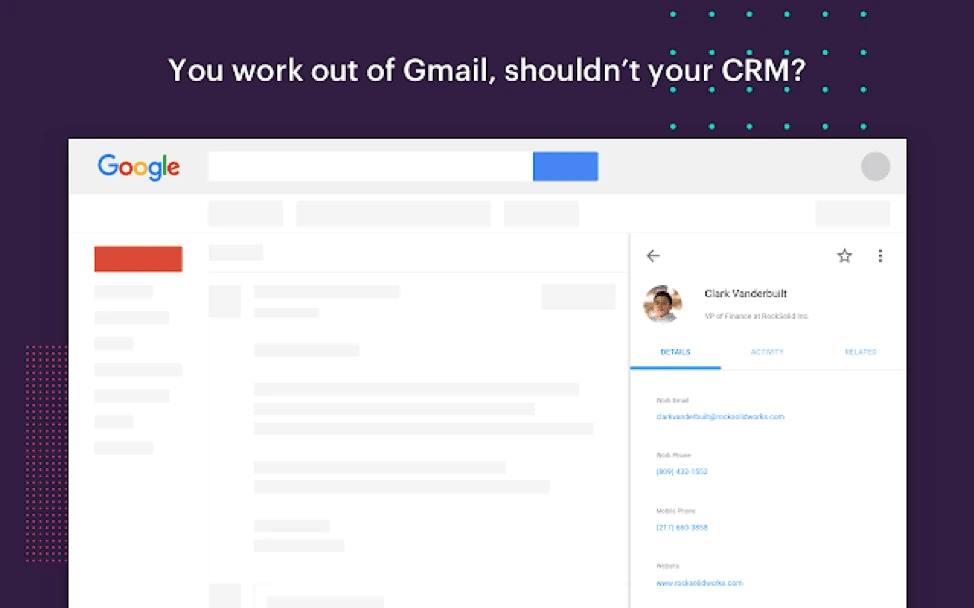
Pricing: From $19 per month.
2. Propertybase
If you need more from your CRM, Propertybase is worth investigating.
This real estate software tracks and manages leads, while also featuring a marketing center to manage email campaigns, real-time lead generation dashboards—and even syndications with platforms like Rightmove and Zoopla.
Granted, it’s more expensive than Copper’s CRM, but it could be the only software you need to manage your brokerage.
Pricing: From $79 per user, per month.
3. QuickBooks
QuickBooks is an accounting tool that real estate companies can use to track their finances. But, what makes QuickBooks different is the control it gives businesses without tons of financial knowledge, looking for more than just a spreadsheet.
You can track transactions, along with:
- Property descriptions—including floor plans
- Lease dates
- Current and market rent
- Due dates
- Appraisal values
Pricing: From $10 per month.
4. Placester
Every brokerage needs a website—that’s nothing new. But if you’re looking for a platform built specifically for realtors, Placester is fantastic.
Placester allows you to build modern, personalized websites with the aim of generating more leads for your properties. And, with several themes and lead capture templates to choose from, you don’t need a ton of HTML knowledge to create a strong website for your real estate company.
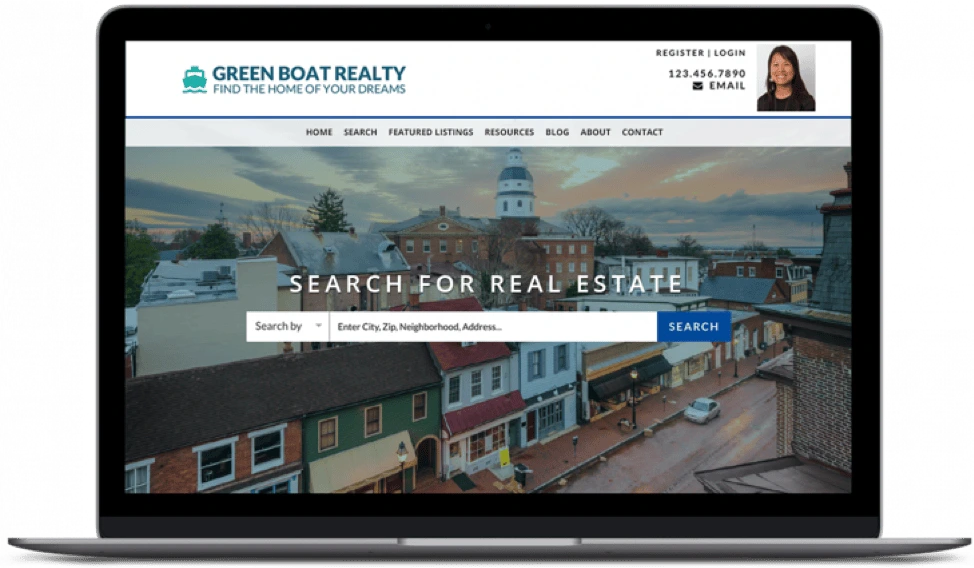
Pricing: From $99/month, plus $99 setup fee.
5. PropertyWare
Are you managing a handful of rental properties at your brokerage? Another real estate software you should add to your list is PropertyWare.
Designed to act as a “toolbox for single-family property management,” PropertyWare is a web-based software that allows realtors to track payments, create online portals for tenants and owners, and screens tenants to make sure they’re high quality.
The best part? It’s built by property managers—so they know what they’re doing.
Pricing: From $1 per unit, per month (minimum 250 units), plus an implementation fee of 2x the monthly subscription.
6. Commission Trac
Creating commission reports can quickly get confusing. That’s where Commission Trac shines.
A real estate platform that allows brokers to manage commission plans, invoices and agent distributions, Commission Trac “streamline back office accounting” and take away the headache from managing commission cuts.
They’ve also partnered with organizations like the National Association of Realtors to offer members 20% off their plans.
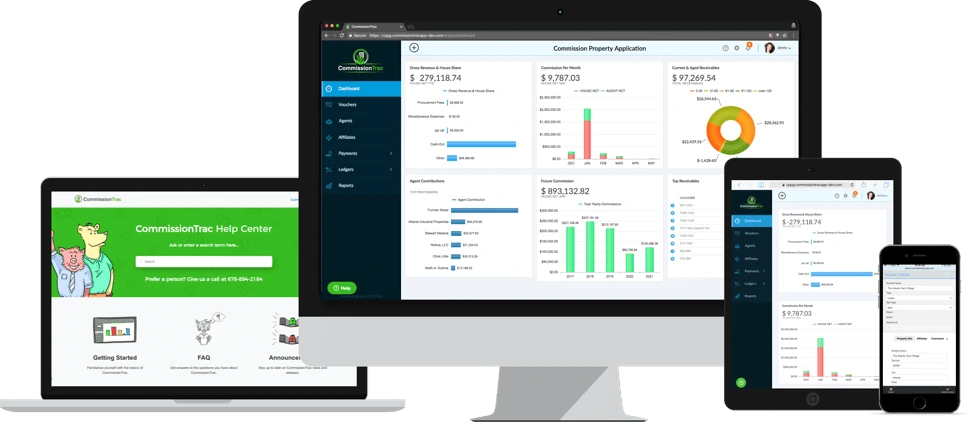
Pricing: From $45 per month, depending on how many agents are in your brokerage.
7. HelloSign
Don’t let paper documents take over your office. Ditch the traditional scanners and use HelloSign instead—a tool that allows your clients or tenants to sign documents electronically.
You can use HelloSign for a variety of electronic documents, including:
- Tenancy agreements
- Mortgage papers
- Offers to purchase
- Closing statements
- Real estate transfer tax returns
Plus, HelloSign documents are legally binding (and enforceable in court).
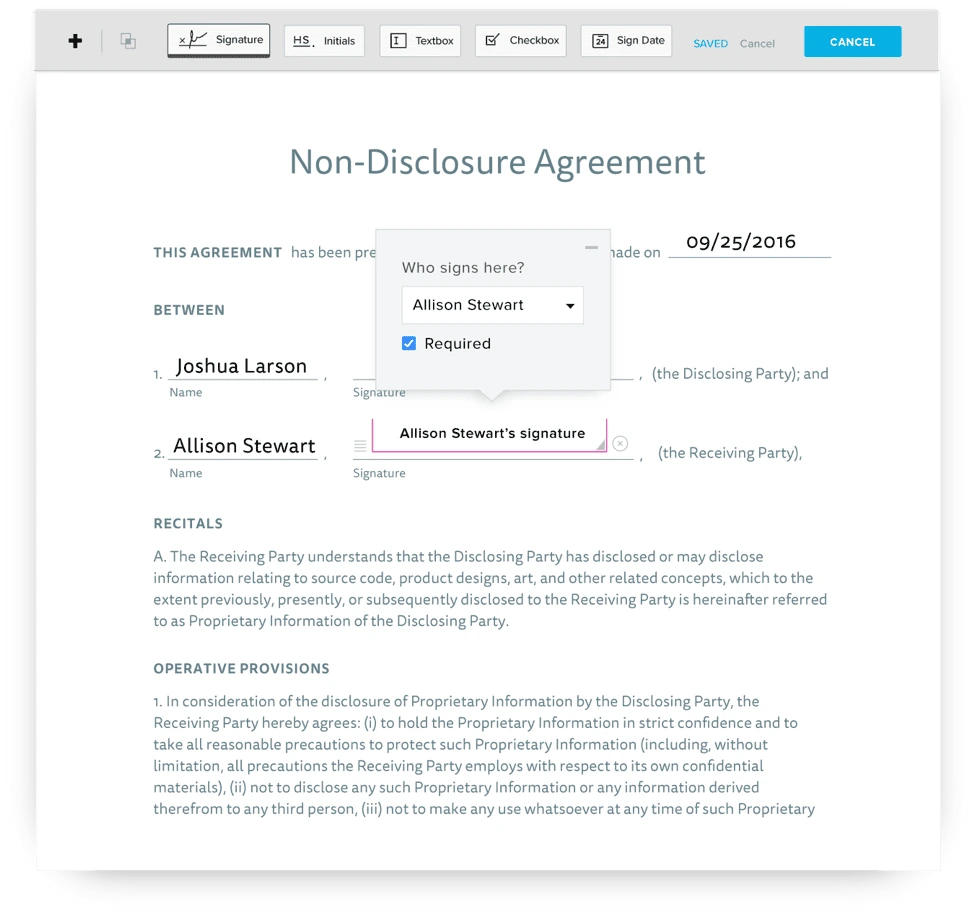
Pricing: Free for 3 documents per month; $13 per month thereafter.
8. ShowingTime
If you regularly schedule property viewings, ShowingTime is a software you’ll love.
ShowingTime is a real estate software that allows brokers to collect analytics and provide feedback on home showings. It also allows realtors to quickly schedule and confirm property showings, while helping to offer better customer service to their clients.
Nobody likes no-shows, right?
Pricing: Custom; demo required.
9. CityBlast
You’re likely familiar with marketing software that can help businesses supercharge their growth.
But, CityBlast is different to the rest. They focus solely on real estate businesses and have a live team who describe themselves as “social experts.”
They provide social media PPC campaigns to increase audience growth—meaning you could see more social followers, site traffic and hot leads if you’re enlisting their specialist help.
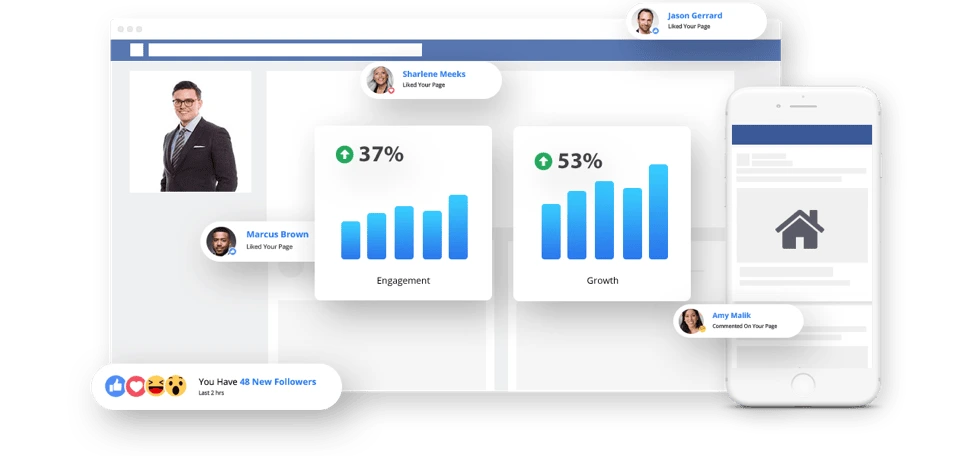
Pricing: From $83.25 per month.
10. AreaPulse
For more in-depth reports on your properties, it’s worth checking out AreaPulse.
In this web-based real estate software, you’ll find every metric you need to track the success of your brokerage, including:
- How long a property has been on the market
- 6-month price trends in the local area
- How many homes you’ve got for sale
You’re also able to send AreaPulse reports to your potential customers, giving them a solid understanding of the property market. Plus, with the ability to track open rates on these emails, it’s a great way to identify which subscribers could become hot leads.
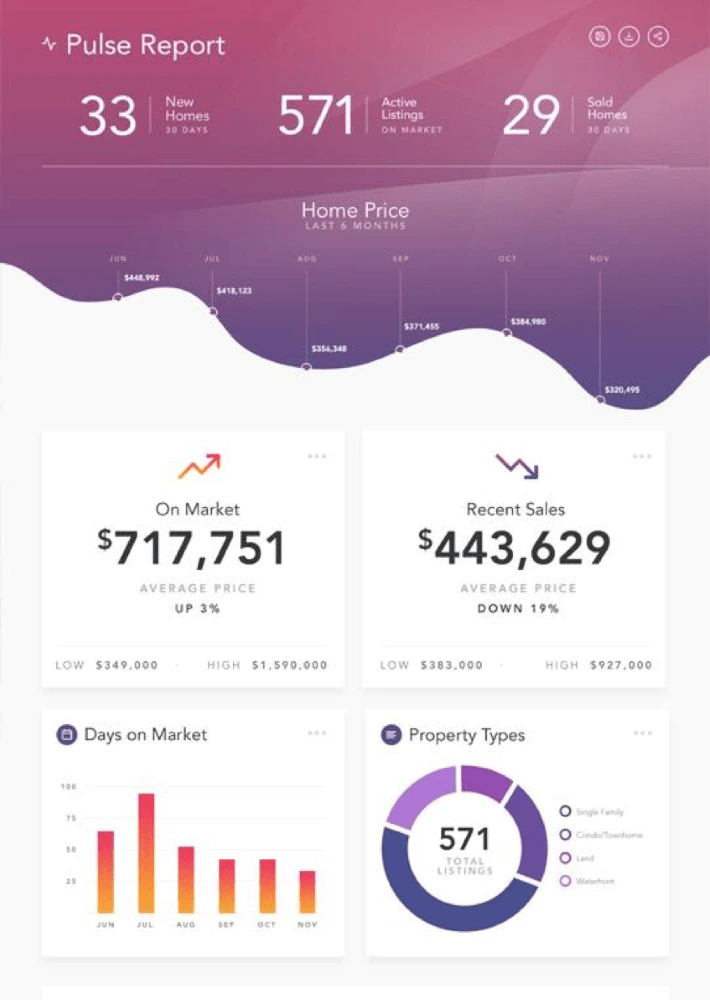
Pricing: From $49 per user, per month.
11. HouseCanary Value Report
Another incredible option if you’re looking to dive deeper into real estate analytics is HouseCanary’s Value Report tool.
They use data science, advanced software and predictive analytics to create the “most accurate automated valuation model”—meaning you get a full understanding of the local property market, forecast returns over the next three years, and set rent fees that are relative to the area.
Sounds awesome, right? (Spoiler alert: It is.)
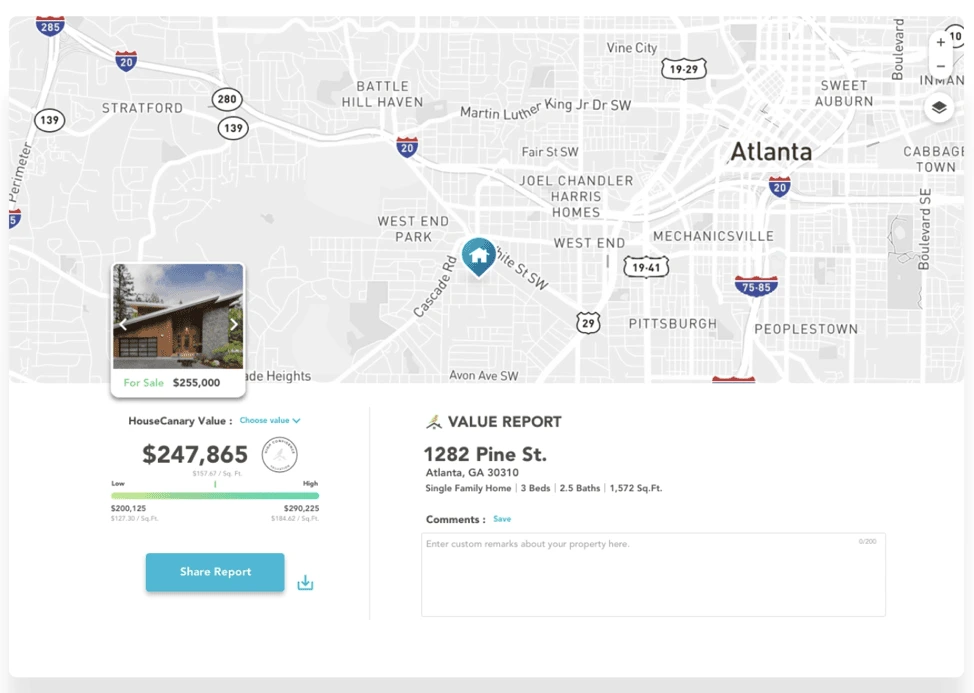
Pricing: Custom.
12. Lucidpress
…We couldn’t share a list of real estate softwares without including ourselves, right?
Lucidpress gives brokers a nifty tool to create branded real estate marketing material—such as PDFs, social media images and newsletters—in one web-based portal.
There are hundreds of templates to choose from, making it perfect for real estate businesses that need ahold of their branding campaigns, but don’t have a clue about graphic design.
(Considering that consistent branding increases revenue by 23% on average, you’d be mad to miss this off your list.)
Pricing: From $5.95 per month.
Key takeaway
Now that you’re well-equipped with the real estate software you’ll need to manage your brokerage, it’s time to start seeing results.
Remember to determine which tools are affordable, and start with tools you need (versus the tools you want). You don’t want to go broke in the process.
You’ll soon be experiencing increased productivity—we’re sure of it.
Get started with Lucidpress, the brand management platform for real estate. It’s perfect for brokerages of any size.
Today, over half of the world (4.89 billion people) use social media. A pretty staggering number, right? What’s more, a typical social media user spends an average of 151 minutes per day scrolling through their feeds. Given all of this, it’s easy to understand why most brands are active on social media today. There’s a huge opportunity to grow your brand awareness here, especially if you follow the right strategy.
So how can you cut through the noise and make sure your brand stands out to the right audience? Let’s go over a few tips that will help you get the most brand awareness out of our social media efforts.
Choosing the right platforms
Right now, there are over 120 social media platforms out there. Thankfully, your brand doesn’t need to be on all of them to have an impact. Remember the phrase, “more isn’t always better”? That’s a good mantra to keep in mind when you’re choosing the platforms you want to be active on.
With so many options, it’s okay to be picky here. To help you get started, consider the strengths and weaknesses of each platform, along with the demographics of its user base and how easy (or difficult) it will be to get your content in their feeds.
Of course, just because one platform is popular doesn’t mean it will necessarily be a good fit for your brand. For instance, if you’re an HR consulting firm targeting c-suite teams, your content might be more suited to LinkedIn than TikTok – despite it being the fastest growing platform out there right now.
One last note here: While we think it’s important to be somewhat picky here, try not to put all of your social media eggs into one basket. As platforms grow and change, they may no longer be suitable for your brand. For example, you don’t have to look very far to see plenty of brands that either paused advertising or left X a.k.a Twitter entirely after controversial changes to the app and its leadership.
Creating a brand persona
Brand recognition = brand awareness. There’s nothing that builds brand recognition faster than a unique, memorable brand persona. Think of this as the voice and POV of your brand. What – or who – does your brand sound like?
Nailing your brand’s personality is one of the most important parts of building a rock solid social media strategy. Knowing your target audience inside and out can help – after all, it’s much easier to develop a brand persona that will resonate if you know the kind of people you’re looking to reach.
But what if you have multiple audiences? No need to fret. You’ll just want to develop a more flexible brand voice that can speak to your different audience segments. For example, you may showcase more of your brand’s fun, humorous side on TikTok, while your LinkedIn presence may be more focused on product updates, internal news, and informative content.
Publishing authentic, consistent content
If you want to thrive in today’s over-saturated market, your brand needs to be consistently producing high-quality, engaging content.
You can start by focusing on topics closely related to your particular niche. For example, if you own a plant shop, you can share information on various plant species, as well as helpful tips and tricks on how to take care of them.
Pre-measured templates are an easy way to start building on-brand content at scale. At Marq, we’ve got a library full of social media templates to get you started.
Lastly, a note on consistency. You can post the most amazing content, but if you’re only posting a few times a year, you’re not going to be able to build the kind of brand awareness that a more active account can. If you’re irregular or inconsistent with your social media branding efforts, your audience might forget about you. (Plus, your absence and lack of posts might even make them think you’ve forgotten about them, too!)
If you can’t post consistently on a regular basis, try using scheduling tools. Schedule your posts at peak times when your followers are most active. This will give your content the best chance to gain visibility and momentum.
Building brand awareness through audience engagement
If you look at successful brands on social media, the vast majority of them interact regularly with their audience. They start conversations, ask questions, and interact with their fans in many of the same ways you might interact with a friend.
Intentionally engaging with your audience can have an incredible impact – not only driving brand awareness but helping people build an emotional connection with your brand.
Here are just a few methods for drumming up engagement on your socials:
- Host giveaways or promotions with branded hashtags
- Sprinkle in user generated content into your social calendar – and encourage your followers to tag you in their own photos for a chance to be featured
- Partner with local or micro-influencers to build a sense of community around your brand
- Respond to audience comments, questions, and concerns to create trust
Key takeaway
It’s not enough to simply have a social media presence anymore. Any brand can publish content, but those that truly go above and beyond have the chance to cultivate a level of brand awareness that rivals the world’s leading companies.
Want to streamline your social media content creation? Check out our template library and start designing on-brand today!
With so much competition for a customer’s attention and loyalty, creating a positive customer experience has become a top priority for brands and businesses. Great customer experiences can ultimately lead to business growth, but some businesses struggle to accomplish a well-curated experience for their consumers.
Taking the time to track and benchmark customer experience metrics can make a huge difference in your quest to improve customer experience. A great starting point is measuring customer experience metrics, including Net Promoter Score (NPS), customer satisfaction (CSAT), customer effort score (CES), customer churn rate and visitor intent.
We’ll show you how to measure customer experience — and whether you use one or all of these metrics, just remember they’re simply scores to help you track and monitor improvements. What’s most important is taking what you learn from any one of these metrics and improving your customers’ experiences with your brand.
Net Promoter Score (NPS)
A Net Promoter Score (NPS) is used to gauge your customers’ overall satisfaction with your brand. When calculated, it can reveal the percentage of customers who may or may not recommend your services to family, friends, etc. An NPS can easily be measured through a customer survey that flat out asks, “How likely are you to recommend [your brand/business] to a friend or colleague?” Through a rating scale of 1-10, you can calculate your NPS by subtracting Detractors from Promoters:
- Detractors are anyone who scores your brand from 0 to 6. This means they are generally dissatisfied with their customer experience and could potentially impact brand perception negatively through word of mouth.
- Promoters are anyone who scores your brand from 9 to 10. They’ve had a positive customer experience, feel loyal to your business and will most likely promote your brand or product/services.
- Anyone in between these two is considered a Passive; those who score from 7 to 8. They’re satisfied but not so loyal they can’t be pulled away by competitors.
By measuring your NPS, you can assess the overall loyalty of your customers. Measuring the NPS is one of the most common customer experience metrics as it’s quick to complete, easy to understand and can give a look into the big picture of customer loyalty.
Customer satisfaction (CSAT)
Another metric used to gauge the overall customer experience is customer satisfaction (CSAT). CSAT can be measured as the average satisfaction score your customers use to rate a specific experience they’ve had with your brand. This can include anything from returning a product to getting an answer from customer support. To measure this, you can send automated surveys to customers asking them to rate their level of satisfaction during this interaction from “not satisfied at all” to “very satisfied.”
Customer satisfaction is essential to growing your business in this digital age where our economy runs on split-second decision making by consumers. To make this metric most effective for your business, try to get a CSAT score within 30 minutes of a customer’s interaction. Getting a here-and-now reaction to your product or service can really help in calculating your CSAT. Be sure to use follow-up questions that dig further into their experience so you can identify pain points and highlight where improvement is needed in the customer experience.
Customer effort score (CES)
A third metric for improving customer experience is calculating your customer effort score (CES). This score helps you determine the effort required by your customers to accomplish a task such as finding the product they’re looking for or receiving a response from a support request.
You can calculate this score with a similar post-interaction survey like the CSAT and asking customers to rate a specific statement. Be sure to curate these statements based on specific interactions. For example, if it’s following a customer support interaction, you could ask, “How much effort did you personally have to put forth to resolve your issue?” Your scale can range from “very low” to “very high.” On the other hand, if you’re gauging how easy it was for them to find a specific product they were searching for, you may use the statement “The company made it easy for me to find the product I was looking for,” and have a scale ranging from “strongly disagree” to “strongly agree.”
One of the biggest reasons customers choose to interact digitally is the ease and lack of effort it requires of consumers. Customers don’t want to work to get something they’re looking for — this is why more and more companies offer online chat support rather than forcing customers to call or go to a physical location for help. In this digital era, your customers will prioritize products and services that don’t demand too much effort.
Note too, the more effortless the customer experience, the higher the satisfaction. This can lead to high-value, loyal customers. And although CES is a more recent metric, it can provide actionable data to help you change pain points quickly in the customer experience journey.
Customer churn rate
Along with the above customer experience metrics, customer churn rate is a great measuring tool. The customer churn rate is the rate at which customers abandon a brand, service or product. This can include customers who don’t make repeat purchases or cancel recurring services that are subscription-based. To calculate your churn rate, divide the total number of customers lost by the total number of active customers for any given period.
If you’re not a subscription-based business, you’ll need to clearly define what constitutes a churn event for your company. For example, if you know most of your customers tend to make repeat purchases within 90 days, then mark any customer who doesn’t do so within this 90-day period as churned. If you are subscription-based, simply divide the number of customers who cancel a service by those you retain. Other ways you can measure this are as follows:
- Calculate overall customer churn during different time frames such as monthly, quarterly or annually.
- Measure churn during specific stages of the customer journey.
- Calculate customer churn based on specific customer cohorts at different time periods. This could include the churn rates of a customer cohort that signed up for a specific promotion.
- Segment churn by customer type and subscription plan.
Visitor intent
Our final customer experience metric is visitor intent. Visitor intent measures why consumers are coming to your page or website. By measuring this, you can discover what users want when they first land on your page and specific problems customers are looking to solve. This metric can also help you gain insight into audience needs along with providing an opportunity to create more relevant products, services, content or even landing pages.
Overall, there are two types of visitor intent: informational or transactional. Users are coming to your page either in search of information or they’re specifically looking to buy something. You can measure visitor intent through website analytics by reaping data around the terms that attract users to your page, which pages they visit and how long they stay on the pages.
Along with this, you can also ask customers directly by creating pop-up questionnaires, customer polls or online surveys. Use targeted questions that are both multiple-choice and open so you can understand the “why” behind their actions.
Give your customer experience program the metrics it needs to generate support across the company and grow your business. The stats show both the consequences and rewards can be high.
Transform your employees into the driving force behind good customer experience.
Webinars don’t have to be a slide presentation snoozefest. In fact, they’re a great option for creating cost-effective content and harnessing the sales leads of your dreams. Hosting a webinar is fairly simple… it’s getting people to come that you’ll have to spend more time on.
We’ll tell you how to host a webinar and rustle up attendees — and we’ll give you tips for creating an engaging experience that’s good for business and fun for your guests.
Benefits of hosting webinars
As long as you’ve got a dynamic speaker and an interesting topic, there are few drawbacks to hosting a webinar.
You have access to a bigger audience
- Theoretically, you could ask people from all around the globe to attend! A webinar is a great opportunity to expand your audience — there are no travel constraints, and concerns about cost and time are almost nil. The low-commitment aspect of a webinar will draw people in like flies to honey.
It’s waaay cheaper than hosting an event IRL
- Without the cost of renting a space, putting up your guest speakers and coordinating a large event, you can instead put funds toward advertising your webinar and getting a healthy list of attendees.
You’ll generate high-quality leads
- Your attendees are basically a bundle of qualified leads. The people who come to your webinar are already at least somewhat interested in your area of expertise, and you’ll capture all their info when they register for the event. Bam! A nice, tidy list of leads to pass along to the sales team.
You can reuse the content
- Once you’ve got a solid webinar under your belt, you can repurpose it in all sorts of ways. Chop it up into choice tidbits and use the video clips in a blog, LinkedIn ads, your next email campaign… anywhere you need an extra boost of expert content.
10 tips for creating and hosting a successful webinar
Here are our top ten tips on how to host a webinar — including the little touches that will keep things on the right track.
1. Choose a platform
You’ll ideally want to pick a webinar platform that you feel comfortable navigating. There are a lot of options out there and they all offer similar features: poll and chat functions, data on attendee engagement and the ability to record. It will probably come down to price and the user interface you like best to help you decide. We like Demio, GoToWebinar and the ubiquitous Zoom.
2. Set the date
Pick a day and time that will work the best for the most people. Make sure you choose a time that’s doable for both the East and West Coast. Something like Friday at 3:00 p.m. EST would work well since that happens at noon or a little later for the rest of the country.
3. Get the word out
Drumming up a good number of attendees is where you’ll put in a lot of work. You need to effectively market your webinar and get people interested. First things first, you’ll want a landing page for the event with information about the topic and speakers, as well as your registration form.
Put together an email drip campaign to send out to prospects and start promoting the event on your social media channels. You’ll want to start marketing at least three weeks before your webinar, but a couple months in advance is ideal.
4. Polish your presentation
You’ll want to spend extra time making sure the visuals for your webinar presentation are on point. Without live, face-to-face interaction, you won’t be able to read the room and get a feel for how your audience is responding. Your best bet is putting together a presentation that you know will keep your guests focused and interested.
The easiest way to put together an eye-catching presentation is to find a perfect webinar template that’s polished and represents your brand well. We’ve got loads of customizable presentation templates that you can tailor with your brand’s logo, colors, fonts, etc.
5. Keep your audience engaged
You don’t want your presenter to just drone on endlessly. Break up the webinar with polls and interactive Q&A sessions. Most webinar platforms come with built-in tools for polls, questions and chat, so your audience can engage with the content or “raise a hand” and ask a question.
You can also create a hashtag for your event so people can discuss their insights during and after the webinar on platforms like Twitter and LinkedIn.
6. Do a dress rehearsal
With big events, you don’t want to be flying by the seat of your pants. Run through the webinar a couple days beforehand so you have enough time to fix any issues that pop up. Make sure your video platform is running smoothly, check that a test attendee can see and hear you clearly, confirm that any transitions between slides or speakers go as planned, and so on.
7. Record it
Make sure you record your webinar! This is what you’ll repurpose into future content. You can go in after the live recording and edit out any glitches or remarks that won’t be needed for a rebroadcast. You can also send out the recording to all the participants, so they can refer back to it in the future.
8. Use a mic
Get a wired headset mic for each one of your presenters. Yes, they look geeky, but it will ensure that everyone can hear clearly. Poor quality audio makes it hard to concentrate and is just plain annoying.
(And please, for the love, make sure all presenters mute their computer notifications while they’re on so listeners aren’t assailed with pings and dings throughout the event.)
9. Have someone there for tech support
The last thing you want to be doing while hosting a webinar is worrying about tech issues. Have a designated tech person on hand who’s ready to handle any problems.
10. Send out a survey after
Send a survey to participants shortly after the event and solicit their feedback. Getting input from your attendees will help you know what went well and where you can improve for your next go-round.
With the right preparation, webinars can be a breeze to plan and a boon for your business.
For help with creating a beautiful, on-brand webinar, don’t miss our free webinar templates.
In today’s digital economy, it’s easy for businesses to look dated quickly and out of sync with what’s “in.” If you’re worried that customers or clients are finding your work or services blasé, you can easily send the message that you are on top of your game with a webinar presentation.
A well-curated webinar presentation can be a game-changer by keeping your branding consistent, visible and top-of-mind. It also engages the audience by offering visuals that help them retain information for longer periods.
With the aid of our modern marketing presentation template, you can easily highlight how your business is staying on top of current trends. And, ultimately, our professionally-designed slide template saves you (or your sales team) time by not requiring you to start from scratch.
To create the perfect webinar slide or webinar template (for others to recreate down the line), follow along with the tutorial below using our modern marketing presentation template.
Best practices for creating a webinar slide
In short, you need your webinar template slides to be:
Captivating

Just as you were taught in school, you need the beginning of your webinar presentation to be captivating.
Remember how your teachers drilled it into you that that first line of your book or essay was the thing that would hook people into continuing [to read your piece]? Well, that same principle will apply for your title webinar slide.
Not only will the title slide be the first thing your audience will see, but it can also potentially be used for promotions along with the splash screen (a.k.a. the thumbnail) for the on-demand version of your presentation.
To create a captivating and enticing title slide, you will need to use a few things:
- Title: Keep the title of your presentation exciting but straightforward. Use an easy-to-read sans serif font.
- Subtitle: The subtitle will be smaller in size than the webinar title and should also be written using the same sans serif font — but with styling such as italics or bold. Use this section to expand on your title so your audience will know exactly why they should click and continue.
- Logos: Never forget to include your logo in any promotional material that your business produces. On your title page, this will clearly show who is hosting the webinar. If you are co-hosting with another company, be sure to include their logo on the title slide as well.
- Image: Select an appealing and eye-catching image as the background of your title slide, or as a supplement to the design. With our modern marketing presentation template, you can see how the title sits on a white rectangle, allowing readers to read the necessary information easily while also providing an engaging and professional look.
Consistent
With any (and all) branding for your business, your webinar slides need to have a consistent color palette, along with consistent font usage and other design elements.
You don’t necessarily need to use brand colors, but the colors should remain consistent throughout the slides. Pick two to three colors that are easy to read with your text and stick with them throughout the entire presentation. You can use these colors for shapes and backgrounds, text boxes, or even as transparent image overlays.
Simple
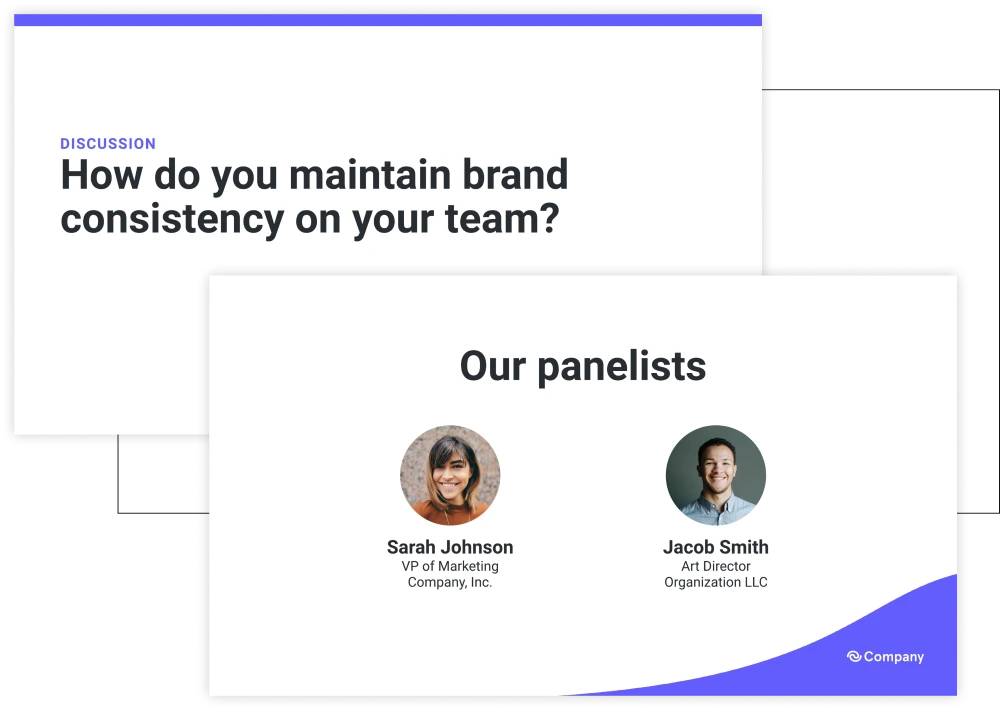
The more crowded your webinar slide deck, the more likely you are to lose your audience.
For example, when creating your webinar template slide, if you create a slide to introduce your webinar speakers, have the slide include headshots of each presenter along with their name and title. Skip the bios. Those can be included in your script, but will only clutter the slide. A good rule of thumb is that if you are going to be talking about the context of the slide in your script, then don’t include it as text, or only do so as bullet points.
Compelling
Include an agenda slide at the start of your webinar presentation. By doing so, this slide will help your audience know what to expect from your presentation.
Make this slide extra compelling — tell them right off the bat what they stand to gain by engaging with you and your webinar. The more compelling this slide, the more likely they are to continue. Remember to keep it simple by using bullet points and keeping the slide’s text concise.
Informative
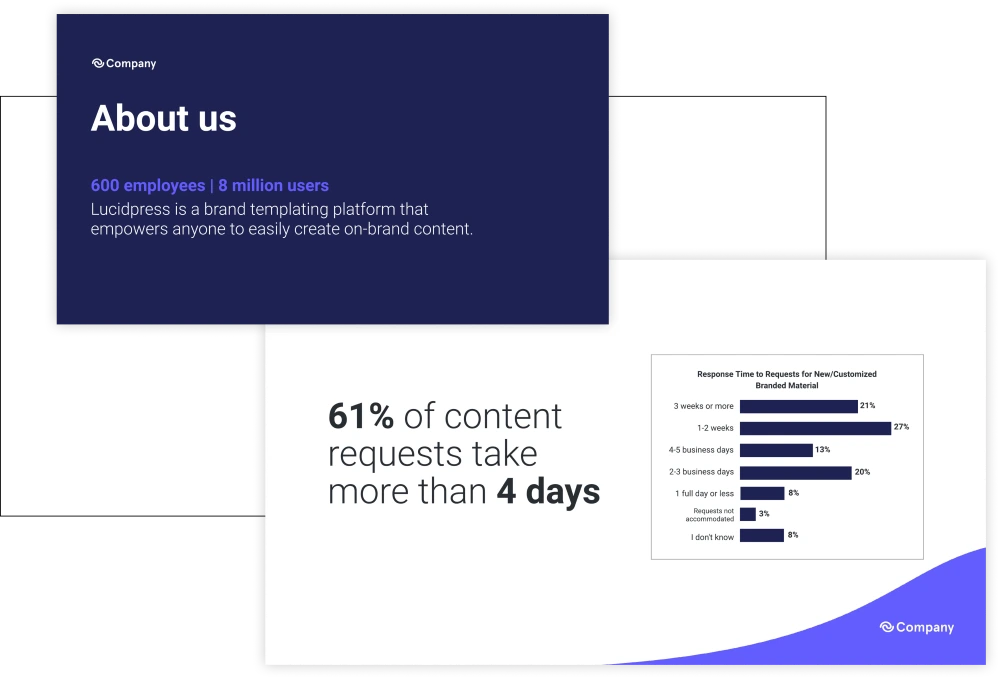
Try to include a few slides highlighting stats about your business or services. Stats can add credibility to your message while also solidifying your script. Infographics are a great way of demonstrating compelling stats.
That said, you also need your webinar to have:
Screenshots
Because we spend so much time on our phones and computers, there is a chance you will need to include screenshots during your presentation to help explain things.
Your webinar template should include slides featuring mobile screenshots and computer screenshots. Again, keep these slides simple: include the screenshot with a couple of explanatory bullet points.
Visual aids

Graphs, charts and icons can take your webinar to the next level.
They will help explain key points while also aiding in getting end goals across. Photography is another way to make your presentation stand out. If you don’t have in-house photography, consider using stock photos.
A recap
A recap slide is a helpful way to wrap up and remind audience members about the key takeaways for your webinar.
Enough of us know what it is like to get to the end of a webinar and have already forgotten several key points. Use a recap slide that provides key takeaways. Repetition will help your audience remember your key message and also give them something to think about after the webinar.
A call-to-action (CTA)
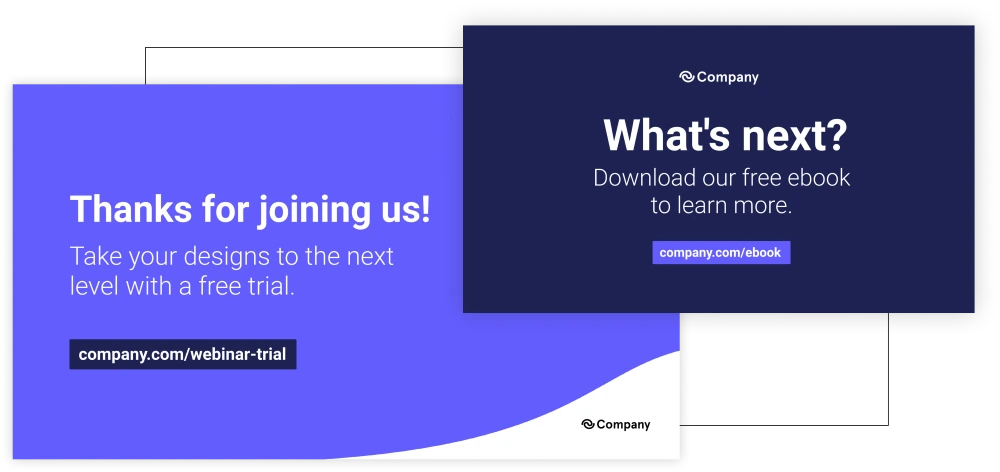
A CTA slide is must-have-necessary for your webinar presentation template.
Use this slide to engage your audience by allowing them to sign up for another webinar, try a new product, complete a purchase, etc. Make sure your CTA truly resonates with the audience and make sure it’s the last thing they see before exiting the webinar.
Let’s get started
Now that you know the elements needed to create the perfect webinar template and presentation, you can start creating your own. Or better yet, download our modern marketing presentation template here and save even more time. You can also find more marketing presentation templates right here.
If you are looking for help in hosting a webinar, check our blog post “How to host a webinar.”
According to the results of a survey conducted by the Chronicle of Higher Education, 55% of private colleges and 44% of public colleges didn’t meet their enrollment goals in 2017. Was your college one of them?
With the looming threat of student debt and a decreasing belief in the importance of going to college, marketing is becoming a crucial factor for institutions who want to boost their numbers.
Related: How to take charge of your university’s branding
And it’s not just about attracting prospective students, either. Engaging your current students is essential if you want to build a strong brand with a positive reputation.
In this post, we’ll tackle the key tactics you need to employ as part of your overall marketing strategy. We’ll also look at some of the hottest trends in higher education marketing today.
Higher education marketing strategies
When it comes to strategies for education marketing, things move quickly.
With a young, digitally minded demographic and the continual emergence of new tech and trends, education marketers must work hard to stay ahead of the curve.
These four tactics will help you tighten up your marketing plan and push it forward.
1. Think mobile-first
Today’s college students live with a mobile-first mindset, using their smartphones as the primary device for carrying out a range of activities.
A recent study from the Interactive Advertising Bureau (IAB) titled Generation Z & Young Millennials: Mobile First on Campus found that 55% of students have acted after seeing a relevant ad on their mobile phone.
For education institutions, this means mobile-first advertising should be a focus in their enrollment marketing plan.
Keys to success for mobile-first higher education marketing:
- Keep the creative work simple and design primarily for the small screen.
- Choose the apps that students use most on mobile—such as Snapchat, YouTube, Instagram & Spotify.
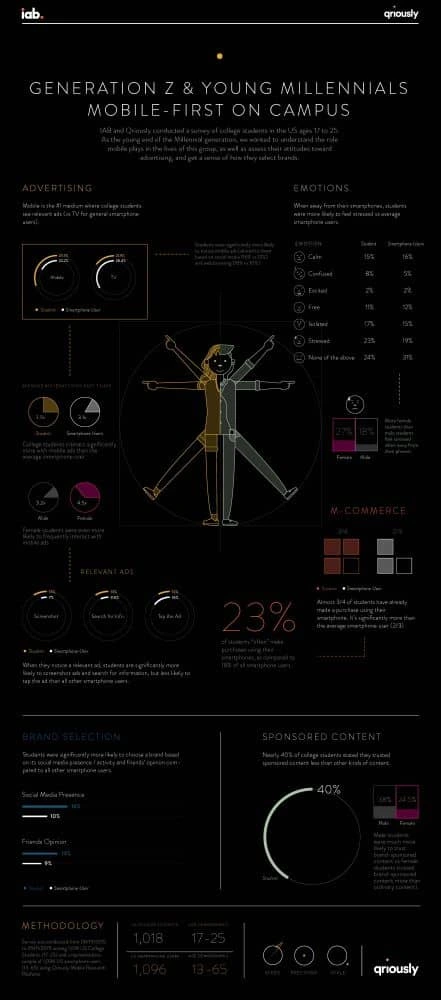
Source: IAB
2. Choose the right social media platforms
That first point nicely brings us to thinking about platform choice in general.
As much as it’s crucial to pick the right channels for digital marketing, it’s also important to think strategically about every platform you’re putting energy into.
A 2019 article from Business Insider reported that Gen Zers between 13-21 used Instagram, YouTube and Snapchat more than any other social media platforms.
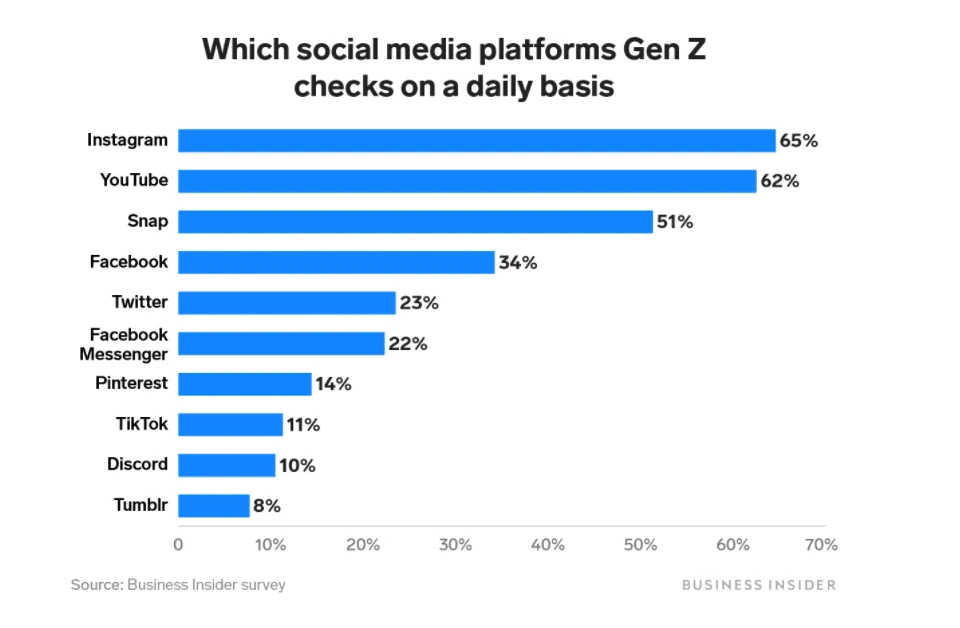
How to leverage the right platforms for successful higher education marketing:
- Pay attention to the numbers and direct most of your energy where young people spend their time online.
- Be creative with your approach, and look for smart ways to integrate new tech (more on this in the “key trends” section below).
- Wondering what to post about? Student and faculty spotlights, alumni updates, photos of campus and event announcements are a great place to start. Creating hashtags for your school, departments and clubs can help increase engagement as well.
3. Build a consistent university brand
Your brand is more than just a logo and a set of colors. It’s the impression you generate from every interaction you have.
As Jeff Bezos, the CEO of Amazon put it: “Your brand is what people say about you when you’re not in the room.”
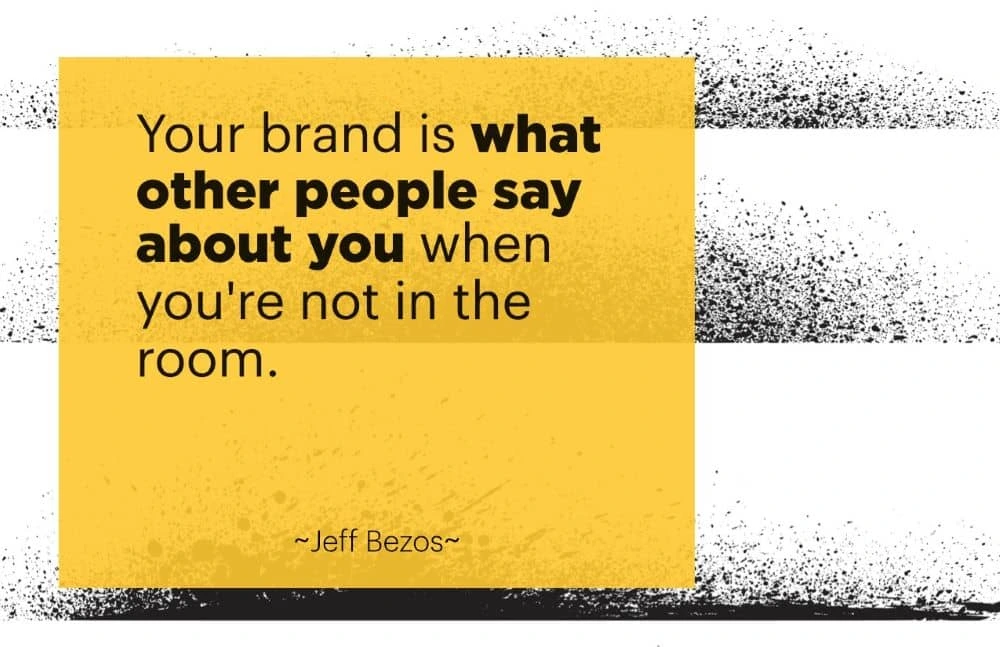
Source: Lucidpress
Brand consistency, then, means maintaining control over the way you’re viewed. It should be a central focus in today’s digital landscape, where the number of channels and touchpoints is continually growing.
If you want a recognizable and trustworthy brand, uniformity is essential.
Tips for building a consistent higher education brand:
- Think beyond the visual aspects and consider messaging and tone of voice, too. How does your content make people feel? How would you describe your brand’s personality?
- Take advantage of a brand templating platform like Lucidpress. Users can easily access and edit branded templates all in one place, and your marketing team will have much more control to lock down brand elements before access is shared.
4. Answer key questions
Using the institution’s website, blogs and emails to answer key questions from prospective students is a tactic that should feature prominently in every enrollment marketing plan.
Research from mStoner found that, contrary to what education professionals believe, most teen college prospects (64%) prefer to consume college website content through text and articles.
Rather than answering the most obvious questions, think outside the box and dive deeper into exploring what’s on your prospects’ minds.
What are they typing into Google? What are they asking their friends? What information are they looking for when they visit your site?
Targeting long-tail keywords in the form of specific, beyond-the-obvious questions will help you increase your search rankings. For example, rather than “student accommodation Chicago,” target search phrases like “what’s it like to live in Chicago as a student” or “where is the best area for students in Chicago.”
How to effectively answer key questions in writing:
- Know the audience you’re speaking to and direct the content to them. Use the type of language they’d use, and make sure any references or explanations are relevant and appropriate.
- Keep it brief and concise, and make sure it’s easy to read and scan through by using clear formatting such as subheadings, bullet points and numbering.
5. Centralize your marketing
With departments spread out all over campus, it can be hard to know what marketing tactics everyone’s using and what’s been effective or not. A centralized marketing department will let you track spending, various campaigns and their results.
With a centralized approach, you’ll be able to align KPIs, standardize your marketing and in turn, standardize your brand. Scheduling regular syncs with each department will help all stakeholders stay in the loop with your school’s central marketing goals.
6. Optimize email campaigns
Marketing automation tools can help you optimize email and reach more prospective students. Email automation platforms will let you personalize messages and send emails at the right time, when they’re most likely to be read. Plus these tools will make sure your emails aren’t routed to the spam folder.
You can also do A/B testing to see which messages your audience responds to better. With A/B testing you can narrow your focus and continue to sharpen your brand’s voice and messaging to appeal to different student groups.
Key higher education marketing trends
Now that we’ve talked effective strategies and overall approach, let’s look at some of the hottest trends you could incorporate into your next campaign.
1. Micro-influencers
Influencer marketing has taken the world by storm, and it’s expected to continue growing over the coming years. An industry already worth $2 billion in 2017, predictions say it could be worth between $5-10 billion in 2020.
But, it’s not all big numbers and big money.
Micro-influencers are on the rise, and while they won’t have the same reach as celebrities or big social media stars, they do have highly targeted and engaged audiences.

Source: Pulse Advertising
In practice:
To incorporate influencers into your next higher education digital marketing strategy, look for socially savvy and well-connected students in your community.
How can you create a win-win situation where they’ll talk positively about their experiences attending—or working in partnership with—your institution?
2. User-generated content
To reach a demographic who yearns for connection and places a high importance on authenticity, social proof is paramount.
More than ever, young consumers look to their peers or influencers in the online world before making decisions.
And when you consider that they spend up to 11 hours per day on social media, it’s clear that’s where you need to be showing up.
In practice:
By encouraging students to share real-life experiences under a common hashtag, you can generate a go-to online community that will increase awareness and engagement.
Beyond that, enable online reviews and share positive data, feedback and authentic stories on social media.
3. Augmented reality
Augmented reality makes real-world experiences interactive, and it’s expected that higher education institutions will begin to adopt it more over the coming year.
A good starting point for some might be Snapchat GeoFilters.
Almost 90% of Snapchat users say they enjoy GeoFilters. A spin on a regular filter (which is a design you can overlay onto a photo you take in the app), GeoFilters are only available in certain locations.
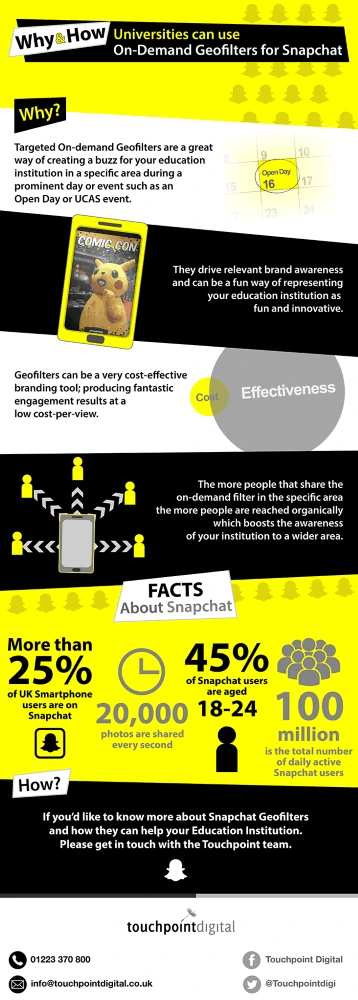
Source: Touchpoint Digital
In practice:
Beyond Snapchat, interactive campus tours, maps & brochures can have a big impact.
Contractors working for The University of Washington built a mobile app that allowed users to explore the new $105-million computer science building before it was built.
The Savannah College of Art and Design boldly embraced virtual reality (VR) back in 2015, sending out Google Cardboard headsets that let 30,000 accepted students explore campuses virtually.
It moved on to augmented reality (AR) next, adding interactive features to a course catalog. The institution has seen a 26% increase in admissions applications after introducing VR and AR recruitment tools.
4. Livestreaming
Livestreaming is being broadly touted as the big must-have for marketers in all industries today. No longer a novelty, it’s changed the face of marketing and the way brands and consumers interact.
When you take a look at the numbers, it’s not hard to see why.
According to Dartmouth, 86% of colleges and universities have a presence on YouTube. That makes sense when you consider that 71% of teens’ typical entertainment consumption is streaming, and one-third is viewed on apps from a mobile device.
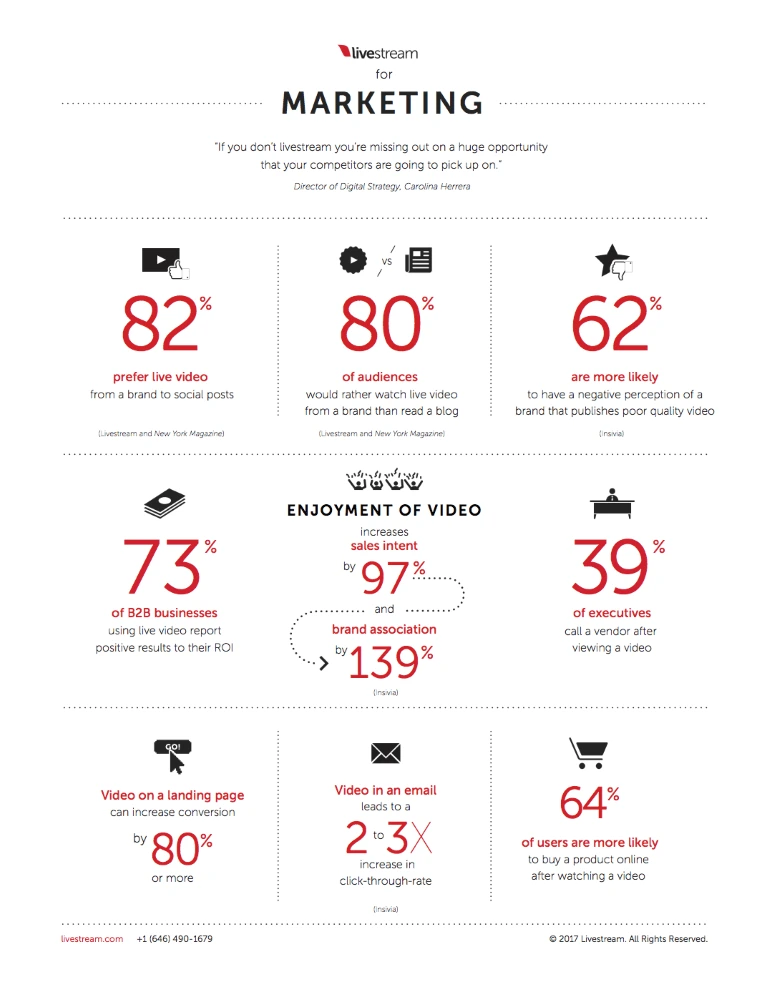
Source: Livestream.com
In practice:
The most common and beneficial use of livestreaming is to broadcast events.
Education institutions can set up livestreams—broadcast either by themselves or by an influencer—to showcase events held throughout the year.
Real-world example
In terms of real-life examples, Western Colorado University struggled to manage their marketing properly for quite some time. It wasn’t until they implemented brand templating software that they were able to keep their brand consistent and save their creative team loads of marketing time.
Sometimes reading the stories of other universities can help shed more light on your own situation. Read Western Colorado’s full case study and see if your creative team has had any of the same struggles.
Key takeaways
In summary, you’ll need to incorporate the following tactics into your digital marketing strategy if you want to hit your enrollment goals:
- Think mobile-first
- Choose the right platforms
- Build a consistent brand
- Answer key questions
To push forward with creative and innovative marketing, the following trends are key:
- Micro-influencers
- User-generated content
- Augmented reality
- Livestreaming
What’s the next big move you’ll make to drive an increase in awareness, enrollment numbers and engagement?
How can higher ed marketing teams build a strong, consistent brand across campus? This downloadable guide will show you how to templatize design at your school.
When it comes to marketing, every team has its challenges. Amongst non-profit organizations, however, those challenges can be vast.
Bound to a tight budget, small teams and few resources to draw from, it may seem near impossible to create a successful marketing strategy to help your organization grow. For some, it may not be clear why a marketing strategy is necessary — you’re not working for profit, so why market at all?
Marketing is more than just getting sales and boosting the bottom line; marketing creates valuable, memorable experiences that positively impact people for the long-term and, therefore, impact your business.
You may not be looking to use your marketing goals to pull in revenue, but the right strategies will still work to bring in traffic (think new supporters or donors), funds and awareness to your mission.
We’ve created a quick how-to for creating a non-profit marketing strategy. By following these steps, you can grow your organization’s impact, and they won’t break the bank.
6 steps to creating a non-profit marketing strategy
1. Set marketing goals
Before you can do anything else, you need to set your marketing goals. These goals should focus on transforming your organization’s mission and objectives into actionable items.
For example, if one of your objectives is to bring clean water to rural areas of a particular country, you should brainstorm three to five marketing ideas for advancing that objective.
One way you could use marketing to advance that objective is to post on social media about your organization and the people you are helping or by sending a weekly newsletter highlighting specific families or individuals impacted by your work.
Once you’ve brainstormed, you should turn these ideas into goals. These goals should be measurable, with specific steps to help accomplish your overall objective.
To provide another example, you could state that one of your goals will be to see a 20% boost in traffic to your social media channels by posting X amount of times a week or month and by interacting with X amount of people on those platforms.
2. Create personas
A big part of marketing is understanding your audience, and one of the best ways to do this is to create personas of your donors, volunteers and recipients.
It’s essential to define and understand each of these audiences because your marketing goals and strategies will differ based on which group you are addressing. For example, an email to a donor will have a different message than an email asking for volunteers.
3. Complete research on fundraising psychology
Being successful as a marketer includes having a basic understanding of human sociology and general psychology — when you know why people behave the way they do, you can start to create content they will identify with and respond to positively.
It will do wonders for you to complete research on fundraising psychology, just like researching consumer psychology aids for-profit businesses. This research can help you understand why more people donate when a campaign is closer to reaching its goal or why some people are more inclined to helping an individual than a larger group.
4. Craft messaging
The next step for creating a non-profit marketing strategy is to craft your messaging. This step is similar to creating a jingle or slogan for any business.
You need to craft a key message that includes all the information your audiences need to hear, remember and hopefully share about your organization. You need to do this ahead of time, as it will help you keep your organization aligned. It will also simplify your marketing while keeping your different audiences organized.
5. Identify strategies and tactics
Although you may want to head straight for this step, setting up your personas and identifying actionable goals will make this step far easier and more successful. At this point, you’ve answered the who, what and how of your key messages and audiences.
Now, you will identify which channels you are going to use. These can include social media, email marketing, events, blogs, etc. Once you decide which channels you plan to use, you will work up the strategies and tactics you plan to use on these channels (we’ll dive more into strategy specifics in the next section).
6. Measure results
It would be silly to implement any marketing strategy without a plan of measuring its success or failure. Doing this step will help you iron out any kinks and further solidify your non-profit marketing strategy. Regular analysis will help you figure out what is working and what isn’t.
Non-profit marketing strategies
The following are the best non-profit marketing strategies that will help you grow your organization’s impact.
Focus on relationships
According to Emily Logan, a longtime activist — as well as a non-profit growth and advocacy strategist — focusing on relationships is one of the most important things a non-profit can do long before asking for anything.
The emotional connection you make between your cause and potential donors can have a more significant impact on your organization than anything else.
It’s not easy for people to part with their hard-earned money and according to VaynerMedia CEO Gary Vaynerchuk, “you can’t just expect someone to donate to your cause without bringing value to them first . . . it’s an open, transparent conversation and dialogue. You need to respect your target audience.”
Capitalize on current events and social trends
One great non-profit marketing strategy is to capitalize on current events and social trends.
Do you know what ALS is? You probably at least recognize the disease simply because of the ice bucket challenge that went viral years ago to help raise awareness of the illness and the search for a cure. The ice bucket challenge became a huge social media trend that everyone was participating in, from grandparents to celebrities. Current events and social trends can be one of the most accessible strategies to utilize when coming up with content marketing ideas.
Work with social media influencers
In tandem with social trends, you should start working with social media influencers.
“Influencer” is in their title for a reason, some of the biggest names have millions of followers, and you better believe that if Jane from Carlsbad tells all the middle-aged moms to go buy this nifty kitchen gadget now, they’re going to do it. People trust individual influencers, and if you can win over a couple who will be able to spread your message, you can make a significant impact.
But, you don’t have to take our word for it. Per studies conducted by TapInfluence, “influencer marketing content delivers 11X higher ROI than traditional forms of digital marketing,” and “influencer content on social media earns more than 8X the engagement rate of brand-direct content.”
Not sure where or how to engage with influencers? Start by looking for micro-influencers in your local community or within your network and then go for the big dogs.
Incorporate video in content marketing
Videos are a huge part of content marketing today, and it would be a massive loss if you didn’t utilize it in your non-profit marketing strategy.
In 2017, HubSpot research found that most people will skim written or audio content, but (more noteworthy) these people were “more likely to pay attention to video content.” You’ve probably already seen other non-profits using this tactic. One great example is Charity: Water’s video — This is Pipeline.
Be sure to follow best practices with video — they don’t need to be lengthy segments to be successful. Also, video also can be produced quite easily without breaking the bank. Apps like Adobe Creative Cloud are affordable ways for a non-profit to create and edit great video content.
Find ways to automate email and text marketing
Email and text marketing can be powerful tools to have in your toolbox. When people join your email or text lists, it’s an indication of their investment — as in they care about your cause and want to support you.
So, this likely means they’re receptive to seeing messages from you in their inboxes. To help you save time, start automating these messages. According to HubSpot research, Boomers and Gen-Xers prefer email or video content, so if they’re in one of your audience groups, you need to use email as a tactic.
Follow up after donations
It may feel small, but having someone follow up after donations can take your message a step further with donors.
It shows you care about them — remember you’re trying to build relationships — more than just their donation. According to research from Software Advice, 60% of donors want information about impact stories, and 46% of donors prefer a personalized letter.
Build trust with consistent branding
Consistent branding is a smart practice for any organization, profit, or not.
In a case study between Lucidpress and MHA, MHA’s Community Marketing Specialist knew they needed a solution to help unify independent messaging. MHA provides care, accommodation and support services for more than 16,000 seniors throughout Britain.
By using Lucidpress’s branding templates, they were able to streamline their messages and work seamlessly with their local homes, getting more done in less time. Having consistent, easy-to-use branding templates can save you a lot of time in the long run. Templates are easy to use for everyone within your organization and can be completely customizable.
Build your non-profit and your brand
By following these content marketing strategies of building relationships, capitalizing on social trends, working with influencers, incorporating video content, automating email, following up after donations and building trust through consistent brand, you will be able to grow your organization’s impact and start to see real results.
Just as MHA found help with Lucidpress’s customizable templates, other non-profits are also finding help with Lucidpress. To learn more, check out how YMCA was able to keep their brand consistent across every location with Lucidpress’s lockable templates.
The long tentacles of coronavirus have touched every aspect of our lives, and especially so for the mortgage industry. It’s not clear where the housing market is going to end up, but right now things are busy.
For consumers, there’s the allure of rock-bottom interest rates, while many people are also facing new, stricter standards for loans. And others are apprehensive about making any moves, literally and figuratively, when the economy is so volatile.
It’s predicted that mortgage lending will reach a 14-year high in 2020. With the surge in refinances, you may find yourself busier than ever. So this is good news… right? We’ll take our silver linings where we can get them.
Amidst the hustle and all the uncertainty, you may be looking for ways to reassure clients, build business, set yourself apart, and work efficiently so you can handle what lies ahead. We’ve thrown together our best tips and ideas for mortgage marketing to help you navigate that new normal.
Behind every loan officer, there is a strategy
Keep these four things in mind as you polish your mortgage marketing strategies.
Be human
Buying a house is enough to make anyone anxious… combined with the stress and unknowns of the current world climate, you’ve got a recipe for, well… even more stress. Doing your best to be as real as possible (aka “human”) can make your clients feel a little better about navigating the mortgage market during what feels like the apocalypse.
Research shows that over 75% of people expect a business to understand their needs and situation. Show potential clients that you can empathize with their worries by simplifying the mortgage process as much as possible. Review your marketing materials and see where you can decode or simplify the language.
But what does being human mean in the context of marketing? You may be wondering, “Aren’t I already human?” Good question. Being human simply means, speaking plainly and communicating with clients in the same way they communicate with you. It means not sounding like a marketer or loan officer. For example, instead of focusing solely on numbers and low interest rates, translate that to what it means for the client. Maybe “Save X% on your monthly payment,” becomes, “Now you can put $X more in your savings account or toward a new car.”
Ideally, all of your communication —everything from the way your company messages itself to how loan officers speak with clients — should be presented in a way that’s accessible, compassionate and personable.
Leverage your visual content experience
Make sure you’re paying attention to your appearance, so to speak. Unfortunately, people do notice the inconsistencies that pop up across your website, social media and printed materials. A study from Salesforce noted that 75% of consumers have come to expect consistency from businesses and brands “with 73% likely to switch brands if they don’t get it. Customer loyalty — and attrition — is determined by every experience. Predictive, anticipatory service is increasingly the norm.”
With large brokerages like Rocket Mortgage becoming more familiar to consumers (and making the market all the more competitive), smaller operations need to throw some resources into branding and customer experience. Maintaining a consistent brand, in both design and voice, can reassure clients of your quality and trustworthiness, which helps your organization stand out in a crowd.
Evaluate where brand inconsistencies are stemming from. Do you need to update your brand style guide? Are brand assets easily available to everyone? Are brokers creating off-brand content? Consider solutions like design templates for brokers that have branded elements already in place. Empowering everyone at your organization to make their own, on-brand content can cut down on the noise and inconsistencies you’re seeing across marketing channels.
Get cozy with digital marketing
Putting together a solid digital marketing plan is key for generating new leads. And social media will offer the most bang for your buck.
We recommend building a solid content plan for LinkedIn — this is where you’ll find real estate agents, brokerages and builders that you can connect with to grow your business. Facebook can also be a great platform for reaching homebuyers — but LinkedIn is the best place to expand your circle and show other people in the industry what your business is about.
Social media is designed for building community, and it’s an ideal place to connect with new people. Taking small steps like reposting listings from agents you’d like in your network and commenting on content that’s interesting to you can help your business grow a healthy following.
Have you helped anyone land their dream home lately? Posting about client success stories makes for feel-good content that people like to see in their feed. Keep the content you post diverse and engaging with a smattering of home-buying tips, mortgage knowledge, property listings, industry news, and anything else that piques your interest.
Automate where you can
Staying on top of digital marketing is no small task — especially if you haven’t got a team to help. Automation could be your best friend, and luckily, there’s not much you can’t automate these days.
- Email — Emails can be easily automated, and it would be a great time to do, say, an email drip campaign about refinancing. Over the course of a few emails you could talk about the benefits of refinancing right now and what the process entails from start to finish. Look into a tool like Mailchimp, which is designed to help smaller businesses automate email campaigns and reach customers without doing much heavy lifting.
- Social media — You can also set up your social media posts to be automated by a tool like Buffer. Automation platforms like this will post content for you based on a schedule you set, and they even have tools that analyze how your content is performing. Good analytics can be helpful if you feel like you’re not getting enough engagement or want to tweak your social strategy.
- Content creation — Certain design platforms (like Lucidpress ?) also offer data automation, which can be invaluable for customized marketing campaigns. Data automation lets you connect to spreadsheets or even your MLS — then you can quickly upload a bunch of information to marketing materials as needed. This is an easy way to create custom collateral for your clients that won’t cost you any extra time or energy.
Take a look at your current marketing campaigns and see what you can automate. Automation will free up your time so you can focus on more pressing things or even brainstorming your next big marketing venture.
However you decide to implement mortgage marketing ideas for the new normal, be sure that your strategies support any long-term goals you might have for your company. Conduct an audit of your existing business continuity plan to see where any of these ideas fit in. Alternatively, it couldn’t hurt to create a new business continuity plan if yours might be a bit outdated. And, if you want to do a deeper dive on how you can strengthen your brand, check out our free ebook on brand consistency and how it impacts your ROI.
Not too long ago, frozen yogurt shops were popping up all over the place. You could create a delectable dessert that was perfect for your tastes because, well, it was created just for you.
Imagine this same approach but in marketing form.
That’s pretty much the idea behind content personalization: the practice of tailoring a user experience to each customer or client. Content personalization creates a unique experience for your clients that can’t be replicated anywhere else.
This type of personalization is important to you because it can equate to keeping customers on your site longer and driving improvement in conversion rates and revenue.
Growth of content personalization
Thirty years ago, our access to content and information hit the acceleration button. On average, you could expect to see about 2,000 ads per day. Today, that number is closer to 10,000, and it’s only increasing due to the growth of content personalization.
The internet allowed the business world to create and publish content for a broad audience that had been inaccessible up until this point. By 2010, the world hit content overload, with over 152 million active blogs. To stand out from the noise, businesses have adopted content personalization as a way to entice viewers to engage with their content.
Benefits of content personalization
Content personalization is valuable. And must be part of your content strategy. The numbers speak for themselves.
- 55% of marketers say personalization increases visitor engagement
- 55% also say personalization improves the customer experience
- 51% say personalization increases conversion rates
Principles of a cohesive, personalized content experience
With the growth of content personalization, the world has become inundated with personalized ads. It’s now expected by customers and clients to see personalized content. Because of this, you need to look at content as a critical part of the customer experience and not just a marketing activity. To do so, you should follow these three principles of the personalized content experience.
Consistency
Your messaging and branding should be consistent at every point in the customer journey. And becomes even more important when developing a personalized content journey. Doing so can be challenging to accomplish, especially as more than just your marketers may be producing content for your brand. In a study of marketers and brand managers, Lucidpress found that consistently presented brands are three to four times more likely to have brand visibility. As you start moving forward with better, more personalized content for your audience, check out Lucidpress’s content marketing platform. It can help your marketers plan and create content while keeping it all in one place.
Scalability
Along with consistency, it’s important to make content accessible by creating a central source of truth and providing tools that non-designers can use to quickly personalize content while staying on-message. A great way to achieve scalability is to create templates of brand media that everyone within your organization can access. Templatizing your brand media provides brand control while enabling everyone to personalize content. This principle can also cut out mundane requests for your design team.
Redefine personalization
Now that you have resources in place, it’s time to redefine your idea of personalization. Personalized content is agile and genuinely reflects your customers. By redefining personalized content, you can start creating content that is so personalized that someone who isn’t a member of that audience doesn’t have the context to get the joke. It will provide extra delight to your desired customer and filter out those who aren’t your targeted audience. To achieve this you must first collect the data you need to understand your customers, distribute that information across your organization and then make personalization easy by creating content that is built to be dynamic.
Examples of content personalization
Accomplishing personalized content can be done in several different ways and across many different platforms, from individually tailored emails to product recommendations. Here are a few examples of things you can do to personalize your content.
Hubspot
Social media is an easy way to gain insight into what your customers are looking for, their pain points, and more. Hubspot leverages this plethora of available information and transforms it into personalized content that addresses customer issues and needs. From there, Hubspot applies the content strategically based on the prospect’s location in the customer journey, which creates more reliable leads and elevates the overall customer experience.
TLDR: From the horse’s mouth — use customer feedback and various other insights to personalize content production.
Slack
Content personalization also involves understanding your various channels. Slack provides a product that makes it easier for teams to collaborate, chat, share files, etc. They have a heavy social media presence, hitting the main platforms, plus a podcast and several blogs. Slack uses every one of these channels to connect with their customers. By being present on each of these channels, they can strengthen their brand identity, build trust and credibility, and start conversations with prospective clients. Because they’re on various channels with different content for each, they can reach a wider audience. Like Slack, you can also use social media to get inside info on your customers and provide even more personalized content.
TLDR: Get social — use social media to build trust and communicate with customers in a digital, yet personalized setting.
Shutterfly
Content personalization can be applied within the product as well. Shutterfly is an app and website that allows you to create photo books, calendars and more with your personal photos. When using their app, Shutterfly can access your photos and then identify pictures with faces in them and place them on items you can purchase from within the app. If you sell products that are already personalized, it can help to show your customers what they may look like before buying them, or even show them what they can do with your product.
TLDR: Lead by example — give your customers reason to see themselves [in your product] by showcasing their peers using it.
Today’s marketers have countless opportunities to create personalized content experiences. And as we mentioned earlier in the article, your customers have come to expect this, too. For many organizations, creating content personalization can feel trivial and overwhelming. But as you start to create better content and forge lasting customer relationships, be sure to check yourself and read our guide on how to deliver the extra 1% and provide customers with a memorable content experience.
Top performers in the tech aren’t just taking content marketing more seriously, they’re being more creative with its uses. We’re seeing top performers treat content marketing as a strategic business function, and we’re telling you, it’s pretty cool to witness the creative results.
Take Wistia for example. Wistia ditched the standard resource page and boring blog posts and instead created an almost Netflix-like approach to content marketing with their Learning Center.
But, Wistia isn’t the only company making waves with its stellar content marketing though. By following these seven major trends in content marketing, you too can start to see success.
Related: Tech marketing strategies
1. Continued growth of content marketing
According to a recent survey by the Content Marketing Institute, half of technology marketers expected their 2020 content marketing budget to be higher than it was in 2019. Meaning content marketing is experiencing a growth surge.
If you aren’t finding success with your current digital marketing tactics, try thinking outside of the box. Check out these examples of content marketing from technology companies that are really making a splash.
Blendtec
You’ve probably heard of Blendtec’s popular YouTube series “Will it Blend?” It’s a social campaign that’s garnered millions of views, and it’s been more than just that. It’s also been a sly bit of product marketing that harnesses the right kind of content for its platform. Blendtec didn’t just start throwing out these videos willy-nilly. They researched what works on YouTube and it’s truly paid off — their channel has 867,000 subscribers and the top video (Will It Blend? – iPad) has over 19 million views.
Squash Games
Co-creator of the cult classic cartoon Rick and Morty, Justin Roiland saw potential in the online fan communities of the show and decided to use it to his advantage when he created the VR brand Squanch Games. Rather than wait for consumers to start conversations about Squanch, Roiland and his team created spaces on the platforms their audience was already using like Discord and Reddit. The discussion channels aren’t overly populated by advertisements or intrusions from Roiland himself, but both websites are linked on Squanch’s homepage, bearing an official stamp of approval.
2. Content for multiple audiences
The average number of audiences technology marketers create content for is 3.8 — thus, expanding your reach beyond one or two audiences can generate new customers quicker than you’d imagine.
It’s more common for technology companies to reach out to multiple audiences on multiple platforms because what works for one target demographic, may not work for the other. The biggest challenge we’re seeing for B2B technology companies is creating content that appeals to multi-level roles within the target audience(s). In fact, 59% of tech marketers say this was their top marketing challenge. To move past this hurdle, we suggest identifying personas at all relevant levels of the organization and create content for each role regularly.
3. LinkedIn as a distribution platform
Don’t underestimate the power of LinkedIn as a distribution platform. We found that 97% of technology marketers use LinkedIn organically while 84% of tech marketers use LinkedIn as a paid platform.
There are demographics available on LinkedIn that you may be completely missing out on. As you move to make your mark on LinkedIn, it’s important to note some new features to be aware of that will ultimately help you reach your target audience:
- LinkedIn Live and LinkedIn Events
- Stories Ads
- Audience Insights
- Document Ads
- Products on Pages (where users can leave reviews similar to G2 Crowd)
- AB Testing/Split Testing
- Campaign Manager Lite
- LinkedIn Business Manager
4. Prioritization of customer loyalty
Current customers are just as important as new ones.In fact, technology companies that see the best results are ones that prioritize customer loyalty — 85% of top performers use content marketing to build loyalty with existing customers. On the other hand, only 58% of all respondents say the same.
By focusing your marketing efforts on current customers, you build an infrastructure that fosters retention and even upsell or cross-sell additional features, products and services.
Here are a couple of other ways you can re-market to pull current customers back in:
- Customer communities: Customer communities can be a safe space for people to “talk shop” with peers, share new information about the industry or even collaborate with other professionals. They can also be a great place to announce eBooks or a new whitepaper.
- Nurturing programs: It’s quite common for B2B technology companies to remove existing customers from marketing automation programs. But rather than lump current customers in with new customers, implement a separate nurturing program for them, with touches occurring less frequently. Instead, try highlighting customer success workshops, live events or webinars.
5. Power of case studies
People trust other people, which is why case studies are one of the most powerful ways to convince consumers that your product or service is the right solution. Among tech marketers, case studies are considered one of the highest-performing types of content.
Case studies can help communicate the value of something technical. By introducing real-world examples, you bridge the divide between the complexity of your product or service, the pain point of the customer and the technical understanding of those involved in the purchase. Surprisingly, case studies are more popular with tech content marketers than with B2B marketers — 82% of tech marketers use them versus 69% of B2B marketers overall.
That said, case studies can be a hard area to get right. Here are a couple of tips for creating useful and successful case studies:
- Introduce the solution and benefit of your product or service right away
- Craft the narrative from a peer-to-peer perspective, and then move beyond
- Humanize the content with pain points or direct quotes
6. Digestible content and interactive experiences
We’ve seen a rise in documentaries and other forms of content as companies look for ways to leverage brand affinity marketing. And while this approach has been used by retail companies for years, tech company branding stands to benefit from it too.
Producing content that connects with your audience on a deeper level can provide something your everyday assets (like sales enablement collateral or email nurture campaigns) aren’t able to.. Your product may feel like a tool more than a service most days, but that can be changed by simply humanizing it (hey, case studies!) through an interactive experience or a fun video series. Don’t believe me? Check out these two companies:
Mail Chimp
One of the first brands to dip their toe into easy-to-digest content, Mail Chimp created a 5-part series called Second Act. The documentaries feature stories of people who were leaving careers to create new ventures. The mini-series highlighted the service that most new companies utilize when starting a business but explained the benefit of it through a heart-warming story of people following their passions.
Yeti
Yeti was among the first brands to create their very own online content highlighting people’s stories rather than focusing on the product. At first, they simply focused on salt of the earth people who used Yeti, but with time, their efforts have moved more towards telling stories that resonate with their audience and leaving the sales-focus behind.
Both of these companies were able to create content that could be turned into a viral series, pulling customers back in, over and over again. A docuseries doesn’t have to be the answer, either. Creating interactive product tours, interactive ebooks, quizzes or personalized content recommendations are all other great starting points that will resonate with your audience.
7. Use of intent data
Intent data is behavioral data collected about a person’s online activities — which is a combination of topic and context data.
Topic and context data provide insight on who the person is behind an action and what topics they’re expressing interest in. For example, by reading this article, you’re expressing a level of interest in trends for technology marketers. This is considered topic data. On the other hand, we might assume that you’re a marketing professional and are therefore searching for a new approach to digital marketing. That’s context data.
Intent data can be incorporated into your sales and marketing platforms to identify and find in-market buyers. Intent data can also be poured into marketing technology like a MAP or CRM. Additionally, 80% of B2B brands are leveraging intent data to help with account prioritization and scoring for ABM initiatives. Successful technology marketers have found that intent data can not only help their sales teams focus their outreach, but it can also focus their advertising dollars to determine which topics to address within their content marketing platforms like social media.
Go from blah to cha-ching
Whether you choose to implement one or all of the trends above, your digital marketing strategies are sure to go from blah to cha-ching. Just remember that quality over quantity should be a priority no matter which path you take. If you’re looking for a better way to give your customers a memorable and unique content experience, check out our eBook on how to get that extra 1% of a memorable content experience.